#Canton Free Library
Explore tagged Tumblr posts
Text
I really recommend ACE by Angela Chen and Refusing Compulsory Sexuality by Sherronda J Brown! If possible and safe for you to do so, consider asking your library to get them!
There's also a lot of good academic articles out there, specifically those by Megan Carroll, Ela Przybylo, M Milks,, KJ Cerankowski, and Canton Winer. These may also be paywalled through, feel free to reach out to me for PDFs! (The screenshot is from Google Scholar)
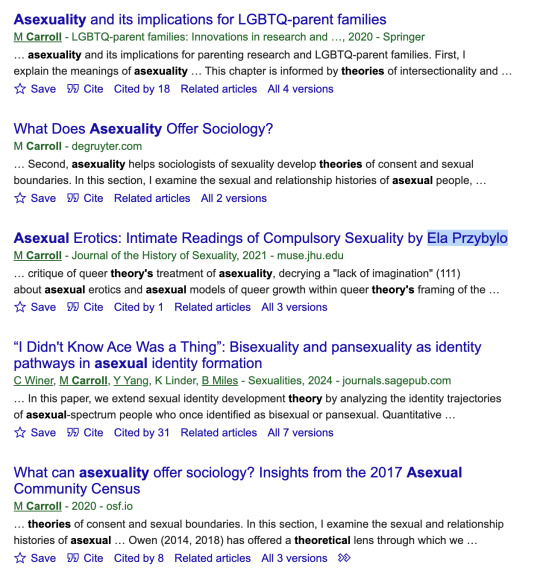
When it comes to asexual allyship a lot of people wanna have their cake and eat it too (pun unintended). People like a lil 'aces are valid' moment but don't actually unpack compulsory sexuality. People see sexless queer representation and always clock puritanism before they ever clock asexuality. No one's actually reading the ace theory and texts coming out. Everyone keeps doing surprised Pikachu faces whenever a conservative or TERF says they're against asexuality despite the fact ace activists have been saying since day conservatives are not anti sex but anti sexual autonomy. 'Aces are queer' until we actually are. Even ace support posts keep ending with some expectation or condition that asexuality is #valid as long as asexuals still perform a small quota of sex/sexual activity. I'm so over 'Aces still have sex!' 'Aces are hot' Aces are sexy' 'Aces aren't virgin vanilla prude sexless puritans!' disguised as support.
Like no. Sorry. Until you accept that some asexual people's no is permanent, that some asexual's singleness is permanent, that some asexual's childless-ness is permanent, that some asexuals are the 'no' in little to no sexual attraction and i'd say most importantly, that queer sexlessness isn't a biological, social or moral failing, I don't believe you'll ever genuinely support asexuality. (In reverse, I also feel similar about aromanticism and romance).
Like a lot of u haven't gone beyond 'the a isn't for ally' and it shows. I don't want people to support asexuals just because we're soooo hot or because we write the best smut apparently or because we could have hypothetical sex or because we could do hypothetical kink or because our minds are soooo dirty actually or because we'd do romance reallllyyyy well or because we can still have kids or because asexuals hand out water bottles at the orgy or some shit. I want people to support asexuality because no sexuality is deviant and it's basic human decency.
#asexuality#ace#asexual#acespec#asexual theory#asexuality theory#asexual spectrum#ace community#asexual community#asexual pride#asexual history#ace pride#ace spectrum
17K notes
·
View notes
Text
Results for Baltimore, MD
∙ Choose area
Your business on Google
This business already has a profile on Google. You can request access to become a manager. Learn more
Request accessOnly managers of this profile can see this
Search Results
Web Result with Site Links
Enoch Pratt Free Library: Home
Enoch Pratt Free Libraryhttps://www.prattlibrary.org
The Enoch Pratt Free Library provides access to books, services, information and opportunities that empower, enrich, and enhance the quality of life for…
Central Library
The Central Library was designated the Maryland State ...
Locations & Hours
Light Street - Canton - Waverly - Southeast Anchor - Herring Run
Books & More
Adults - Library of Things - Marina Interlibrary Loan - Young Children
Services
Passport Services. Need to apply for a passport? The Central ...
Contact Us
Call us at (410) 396-5430. Telephone reference is ...
Enoch Pratt Free Library
4.6312 Google reviews
Public library in Baltimore, Maryland
Website
Directions
Reviews
Save
Share
Call
Description
The Enoch Pratt Free Library is the free public library system of Baltimore, Maryland. Its Central Library is located on 400 Cathedral Street and occupies the northeastern three quarters of a city block ... Wikipedia
Address: 400 Cathedral St, Baltimore, MD 21201
Architect: Edward Lippincott Tilton
Opened: 1882
Phone: (410) 396-5430
Hours:
Open ⋅ Closes 5 PM
Branches: 22
Director: Chad Helton, President and CEO
0 notes
Text
492
Library of Circlaria
Remikra Timeline

Kilm: The Five Lords and Houses
Bisected by the Deepnarrow River, which ran Northwest to Southeast through the city in an S-shape, the center of Kilm, in the fifth century, consisted of a large multi-tiered Palace built over the River, underneath which existed docks to serve passing merchants. South of the River lay the West and South Cantons of the growing city, while the North and East Cantons lay to its North. Medieval Kilm under the Edoran Kingdom was governed mutually by five Lords, each from their respective House in their Canton. The Town Square in the center was, in the early 400s, governed by Lord Sir Alexander Thomwell; the North Canton was governed by Lord Sir Robert Kayndon; the South Canton was governed by Sir Paul Teemor; the West Canton was governed by Sir John Borwell; and the East Canton was under the Lordship of Sir William Benson. The official roles prescribed to these Lords was to each employ a division of knights to defend his respective Canton, and to each collect taxes from the serfs, who were employed by wealthy guild owners.
Lord Donmar's Agenda
Initially, the Lordship establishment was disliked by the serfs, who stated grievances of family separation for labor purposes, as well as lack of rights, lack of free choice, high taxes, and long work days.
In the autumn months of 399, Lord Benson, who was on his deathbed, appointed Sir Kenneth Donmar, from Fort Norm, to be his successor. This appointment was approved unanimously by the other four Lords; and a letter from King Samuel I also expressed approval. In January 400, upon taking his new role, Sir Kenneth Donmar publicly insulted and dehumanized the working serfs, drawing contempt from the masses. However, such contempt was unheard. And with large amounts of gold rewarded to him by King Samuel I for the defeat of the Kilmian city-state, Lord Donmar vowed to convert each of the Canton Lord's Houses, including his own, into large Palaces similar to that in the Town Square District; and around each, he would construct a large courtyard. The issue was that the space required for such expansions was already occupied by many of the living serfs. Donmar addressed this by forcing the serfs to live in smaller spaces along the margin of each Canton. With no opportunity for input from the serfs, themselves, the Lords unanimously approved of this project in March. And very soon, the plan went into action.
Instan's Uprising
In September 401, Instan, a serf from the West Canton, began to realize the end agenda of their labor, and wasted no time rallying the other serfs in his and other Cantons to protest. Street riots ensued, but in December 401, the ruling Lords had all of them arrested; and Instan was jailed for five years. In March 407, after his release, Instan was sent to labor in the surrounding farmlands as part of a parole for "redemption." In September, he fled his post and arranged secret meetings with serfs in and around Kilm for a coup. In March 408, Instan and his forces attacked from within the Town Square with blades, arrows, and spellfire. The Lords retaliated, massacring the rebelling serfs and executing Instan.
The Restructuring of Kilm
Other serfs not directly involved in the coup began to protest in the streets, as the Lords wrote to the King for help. King Samuel II, who was now the incumbent King, ordered all serfs currently living in Kilm to be divided and sent into different counties in exchange for the inflow of serfs from those respective counties. Upon the incoming new serfs, Lord Donmar imposed a doctrine, as they were sorted into their Cantons. According to the doctrine, and relative to the Lord of the assigned Canton of each serf, the "other Houses" and "other Lords" were conspiring to exclude their Lord and House, and that the said Lord was the only one in Kilm who was not corrupt. Part of the role of each serf was to prepare for the ultimate battle, which the presiding Lord feared would be initiated by the "other Houses," and that their House was to win and restore peace to Kilm.
Meanwhile, Donmar's policies continued; and the successful completion of all the large Palaces and Courtyards warranted the promised feasts in the Great Halls of these Palaces in the autumn months of 426.
The Gang War Games
In each Canton, some serfs were made to construct 100-foot tall stone walls around their respective district, while others trained in combat to fight the "other Houses." Another sector of serfs reported to the central Town Square to work for some of the guilds, where they encountered serfs from other Cantons.
Meanwhile, in the decades that followed, the presiding Lords' on settling minor disputes, most commonly the acquisition of surrounding farmland, involved setting up serfs' duties to spark conflicts. Individual serfs or factions of them would ultimately challenge each other to duels or battles, provided that the conflicting parties were from different Cantons. When such conflicts arose, the Lords would secretly meet to establish announced times and places for these conflicts to happen. Such venues were turned into arenas as spectators would watch the events unfold. The Lord and Canton of the winning party would get the favorable upper hand in the minor dispute, while the losing party in the aristocracy would receive some gift of consolation; thus, diplomacy would be maintained between the Lords.
George Manning, Upbringing
By the 480s, leadership in the Houses and Cantons had changed considerably. The Town Square was now governed by Lord Sir Dennis Fillhorn; the North Canton was governed by Sir John Kayndon; the South Canton was governed by Sir Robert Teemor; the West Canton was run by Lord Sir James Borwell; and the East Canton was under the Lordship of Sir William Benson III.
A son of the owner of a ship building guild, George Manning was initially friends with Lord Dennis Fillhorn of the Town Square district. He had access to the Lords' meeting quarters and was educated on such matters. Furthermore, he had access to their Library. Early on, Manning was indoctrinated with the belief that there was friction between the Lords, which was manifesting into the serf conflicts within the city. Worried about the loss of stability in the city's political landscape and a man of the Alconist faith, George Manning consistently prayed for peace. In his early adulthood, Manning began attending the Royal College of Town Square to study further material in ship building.
Library and Enlightenment
In September 484, an especially brutal rivalry arose between families of the East and West Cantons; and a ship battle in the River was announced to take place at the Southwest Edge of the city on 15 November. It was during such announcements that Manning observed with question how the upper establishment would regulate the logistics for these battles to happen, and further questioned the rules governing the number of ships used, as well as the type and amount of weapons. On the evening of 15 November 484, as scheduled, the conflict began. Ships from the South Canton attacked and overcame the ships from the East Canton. A signal was given by the Mediator for the archers on the East Wall to shoot flaming arrows on the Southern ships, thus destroying them. The Mediator declared victory for the East Canton. While observing this, Manning also took note of the Lords sitting together on a high balcony along the South wall. After the conflict, Manning spied on a secret meeting between the Lords, where he discovered the cause of the conflict to be a dispute between the respective Lords over farmland Southeast of the city. Sir William Benson III, in accordance to the conflict outcome, gained the land, but offered consolation to Lord Teemor through his daughter's hand in marriage. Thus, the two Lords came to a diplomatic consensus.
Not long after this, George Manning went to the Library and crossed into a restricted section, where he discovered manuscript detailing the uprising of Instan. Further research taught him of the fall of the ancient Republic of Karlin.
The Crossing of Boundaries
In January 485, Manning emerged out of his deep Library studies and relayed what he found to a group of close friends. That March, they began a secret distribution of pamphlets to serfs in all of the Cantons and Town Square. However, before anything could materialize, an unknown defector tipped the Lordship of Manning's secret agenda. Manning and his followers were arrested, divided, and sent to work on surrounding farmlands outside the city.
The First Attack
While in his assigned farmland, between January and June of 486, George Manning gathered followers, and set up an underground system that united his original followers on the other farmlands. One night, they met and planned a coup, where they would retake Kilm and re-establish it as a democratic city-state. They would then move to overthrow the Edoran Kingdom and re-establish the Republic of Karlin.
In September 486, recruited forces under Manning's leadership commandeered merchant ships and snuck into the dock ports under the Town Square Palace. From these sprung infantry and archers, who pushed out into the Town Square as the Palace fell under Manning's control. They aimed to attack and capture the surrounding Cantons; but the Lords struck back, attacking them with eagle-riders who shot arrows and spellfire discharges. Furthermore, infantry dispatched by the Lords pushed Manning's forces back toward the docks. Having lost this battle, Manning attempted to escape, but was found and arrested.
The Second Attack
George Manning was thrown into a dungeon in the South Canton, where he was set to be executed. His remaining forces were either imprisoned or divided and sent to farmlands near Norm and Daylram. In March 487, however, Terrance and Maen, spellcrafters and Manning's closest followers, who managed to escape being captured or killed, helped Manning escape to freedom. Between June and October of that year, the three figures established a secret Kingdom-wide underground system with hidden posts in every county. With this, they recruited large numbers of rebelling serf-warriors, especially from Daylram and Norm. In November 487, they attacked, overthrowing the two cities, as they were brought quickly under Manning's control. In December, they attacked Kilm. This time, Manning's agenda succeeded, as all five Lords were executed, and Kilm was brought under Manning's control. Soon, they pushed Edoran reinforcements to the Circlarian Coast and up toward Edora proper.
War: Establishment of the Reformed Republic of Karlin
King Samuel V readied thousands of knights and soldiers. In February 489, he launched them in a sweep that captured Daylram and Norm, and placed Kilm under siege. In March 489, Manning, Terrance, and Maen snuck past the siege lines and traveled to Wannonia, where they spoke to Empress Alexia VI for help. The Empress obliged and sent Wannonian mercenaries, who, in April 490, attacked from the West, breaking the siege and joining with Manning's forces. Together, they swept Northward, re-capturing Daylram and Norm, and placing Edora proper under siege. King Samuel V dispatched night-eagle riders to the Maurangans, a fleet of pirates in the Circlarian Ocean, to ask its leader, Torchae, for help. Torchae agreed, and, in June 490, dispatched his entire fleet as reinforcements. By September, they arrived in Edora proper, where they broke the siege and swept toward Daylram and Norm. In May 491, however, after struggling in vain to re-capture the two cities, reinforcements from Alexia VI slaughtered Edoran and pirate forces. One year later, the King approached Manning with a message of surrender, calling for a treaty.
September 492: The Treaty
Signed in September 492 between the parties involved, the treaty recognized the Reformed Republic of Karlin as a sovereign nation. A boundary was drawn North of Daylram. All land to its South, including Daylram, belonged to the new Republic; and all land to its North belonged to the Kingdom.
Another Change in Wannonian Leadership
In October 492, Alexia VI died peacefully. However, with no daughter to succeed the Throne, the dynasty of the Alexias was brought to an end. Instead, Alexia's son, Justorran, would take her place.
<- 394 <- || -> 499 ->
1 note
·
View note
Text
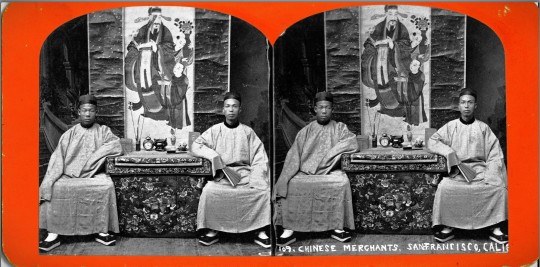
“109. Chinese Merchants, San Francisco, Calif.” c. 1890 – 1899? Stereograph by Nesemann Woods Gallery, Marysville CA (from the Wallace B. Chung and Madeline H. Chung Collection of the University of British Columbia Library).
Merchants of Old Chinatown
In the late 1840s and the 1850s, Chinese merchants and traders made their initial foray into California. By February 1849, the number of Chinese had increased to 54 and by January 1850, historians would count 787 men and two women in San Francisco. In December 1849, the Alta California newspaper reported that 300 Chinese convened a meeting at the Canton Restaurant on Jackson Street for the purpose of organizing the “Chinese residents of San Francisco” and engaging the services of lawyer Selim E. Woodsworth to “act in the capacity and adviser for them.”
In his book, Genthe’s Photographs of San Francisco’s Old Chinatown, historian John Tchen wrote about the vanguard of old San Francisco Chinatown’s merchant elite as follows:
“These pioneers hailed primarily from the Sanyi (Saam Yap) or Three Districts [三邑], as well as the Zhongshan area in the immediate vicinity of Canton. It's important to note that Nanhai (Namhoi) and Panyu (Punyu) stood out as the most prosperous districts within Guangdong Province. Their economic pursuits ran the gamut from cultivating fertile agricultural lands, breeding silkworms and fish, to crafting silk textiles, producing ceramics for both domestic and international markets, and engaging in various other commercial endeavors. “What set apart the merchants and artisans from Sanyi and Zhongshan was their mastery of a more refined city dialect compared to their Siyi (Sei Yap) counterparts, who mainly consisted of poorer, rural communities. Remarkably, over 80 percent of Chinese immigrants in North America originated from the Siyi [四邑] region. A noteworthy portion of these Sanyi merchants belonged to the emerging class of compradores, individuals who facilitated business transactions on behalf of Western trading companies. These California-based Sanyi merchants thus brought prior experience in dealings with Western entrepreneurs, and California was seen as a promising arena to expand these lucrative connections.”
With the completion of the Transcontinental Railroad in May of 1869, the more sophisticated and adventurous members of San Francisco’s pioneer Chinese merchant community would begin exploring other cities in the United States in search of opportunity.
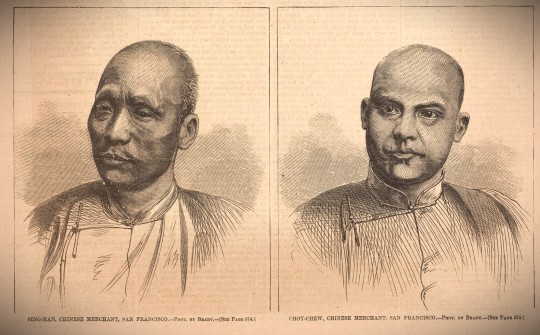
“Sing-Man, Chinese Merchant, San Francisco” and “Choy-Chew, Chinese Merchant, San Francisco,” Harper’s Weekly, September 4, 1869, wood engraving on paper. Artist unknown, artist after a photograph by Mathew Brady, 1869 (from the collection of the National Portrait Gallery).
For example, in the Harper’s Weekly article (Sept 4, 1869, page 574), the reporter identified merchant Choy Chew as a San Franciscan and a talented linguist of sufficient intellect and stature to be invited to give a speech at a European-American banquet. He reportedly visited Chicago with a fellow merchant, Sing Man, before traveling to New York where the pair were regarded as “representatives of Chinese industry and commerce.”
At the banquet in Chicago, Choy Chew delivered the following remarks:
”Eleven years ago I came from my home to seek my fortune in your great Republic. I landed on the golden shore of California, utterly ignorant of your language, unknown to any of your people, a stranger to your customs and laws, and in the minds of some an intruder — one of that race whose presence is deemed a positive injury to the public prosperity. But gentlemen, I found both kindness and justice. I found that above the prejudice that had been formed against us, that the hand of friendship was extended to the people of every nation, and that even Chinamen must live, be happy, successful and respected in ‘free America.’ I gathered knowledge in your public schools; I learned to speak as you do; and, gentlemen, I rejoice that it is so; that I have been able to cross this vast continent without the aid of an interpreter; that here in the heart of the United States I can speak to you in your own familiar speech, and tell you how much, how very much, I appreciate your hospitality; how grateful I feel for the privileges and advantages I have enjoyed in your glorious country; and how earnestly I hope that your example of enterprise, energy, vitality, and national generosity may be seen and understood, as I see and understand it, by our Government … ”We trust our visit, gentlemen, may be productive of good results to all of us; that the two great countries, East and West, China and America, may be found forever together in friendship, and that a Chinaman in America, or an American in China, may find like protection and like consideration in their search for happiness and wealth.“ -- from the Scientific American, new series, vol. 21, no. 9, p. 131 (August 28, 1869)
The founding in 1888 of the Merchants’ Exchange in old San Francisco Chinatown represented the logical culmination of several decades of robust business operations by the pioneer Chinese merchants in the city and beyond.
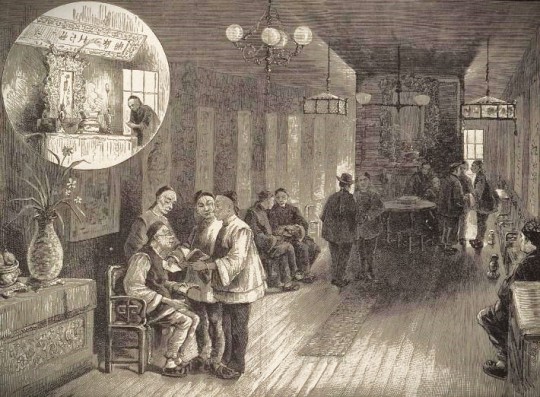
“Chinese Merchants’ Exchange, San Francisco.” Lithograph from Harper’s Weekly, Vol. 26, March 18, 1882 (from the collection of The Bancroft Library, University of California, Berkeley.
In his book, A Guide Book to San Francisco (published by The Bancroft Company in 1888), John S. Hittell described the Chinese Merchants Exchange as follows:
“At 739 Sacramento Street are the new rooms of the Chinese Merchants' Exchange. They are fitted up in the ordinary Chinese style, and though presenting no special attraction to the visitor, the business transacted there is of considerable importance. A Chinese merchant, contractor, or speculator never starts on any enterprise alone. He always has at least one partner, and in most cases several. He makes no secret of his transactions, but converses about them at the exchange, and often goes there in search of capital when his own means are insufficient. He sometimes applies to that institution to find him a capable man to manage a new business which he is about to start. If, as often happens, one be selected who is in debt to other members, they make arrangements which will not interfere with the new enterprise; and the debtor is not unfrequently released from his obligations.”
Fung Tang
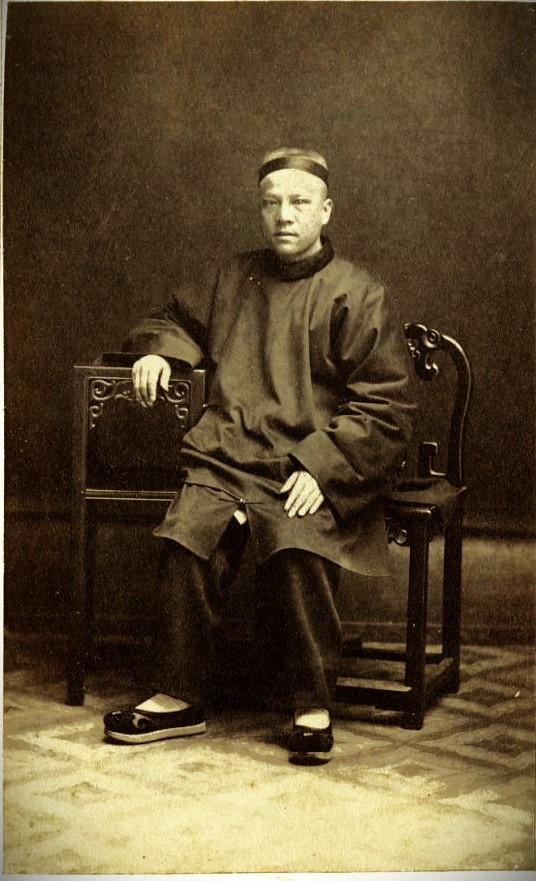
Fung Tang, c. 1870. Photo by Kai Suck (from the collection of the California Historical Society).
The address of the Merchants’ Exchange at 739 Sacramento Street was hardly surprising, as it shared the same building which had housed the mercantile house of a legendary merchant, Fung Tang. Historian York Lo, in his article for The Industrial History of Hong Kong Group website, described Fung as “a native of Jiujiang (Kow Kong) in the Nanhai county (南海九江) in Guangdong, Fung Tang followed his uncle Fung Yuen-sau (馮元秀) to California in 1857 at the age of 17 and worked at Tuck Chong & Co (德祥號辦莊), a trading business founded by his uncle and his fellow Nanhai native Kwan Chak-yuen (關澤元).” In the Langley San Francisco directory of 1868, the Tuck Chong & Co. is listed as “(Chinese) merchants” located on Chinatown’s first main street at 739 Sacramento Street.
“In his spare time,” York Lo writes, “he learned English from Reverend William Speer and became fluent in the language. With his linguistic skills, he became a bridge between the Chinese and the white community in San Francisco and even befriended Peter Burnett, the first Governor of California, who described Fung in his memoir as ’a cultivated man, well read in the history of the world, spoke four or five different languages fluently including English, and was a most agreeable gentleman, of easy and pleasing manners’.”
As such, Fung Tang must be considered as a logical client for the pioneer Chinatown photographer, Kai Suck. A professional studio portrait would have conferred respectability in the eyes of the non-Chinese businessmen and politicians with whom he interacted. In fact, Fung appears to have deployed the same portrait now reposing in the collection of the California Historical Society as part of his commercial advertising in Hong Kong.
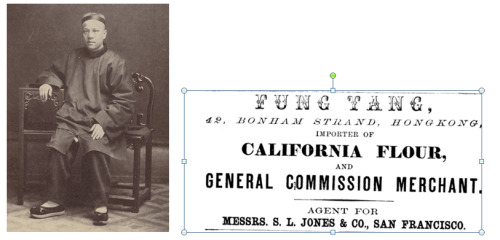
An advertisement for Fung Tang’s flour import business in the Sheung Wan district of Hong Kong.
For more details about Fung’s business exploits and his public service, including his election to the board of directors of the Tung Wah clinic (the original predecessor organization of the future Chinese Hospital), readers are encouraged to read York Lo’s piece here: https://industrialhistoryhk.org/fung-tang-the-firm-the-family-the-transpacific-metals-trade-and-tin-refinery/?fbclid=IwAR3DU6pEcaEw6w2uH1OZvFBFL8vg-Rl4keBS-VkbcttFuHKlx973g3ZjcY8
Tchen asserts that the influx of British and other Western imperialist powers into China’s major treaty ports transformed the status of merchants engaged with Western trading companies. Rather than operating on the margins of Qing-era society, the merchants gained unprecedented prestige and influence. Beyond China's borders, they experienced far more freedom to engage in trade and amass substantial profits without the worry of state-imposed restrictions. They rapidly acquired the necessary language skills and business acumen to navigate their newfound opportunities.
San Francisco’s early Chinese merchants swiftly grasped the English language and American business practices, excelling in American-style transactions, and developing strategies for fostering positive relations with the general San Francisco populace. The local press affectionately labeled them "China Boys." They made conscious efforts to participate in the celebrations of significant American holidays, further endearing themselves to the San Francisco community.
This approach significantly bolstered their rapport with the local population, as evidenced by the California Courier's glowing praise: “We have never seen a finer-looking body of men collected together in San Francisco. In fact, this portion of our population is a pattern for sobriety, order, and obedience to laws, not only to other foreign residents, but to Americans themselves," declared Cornelius B. S. Gibbs, a marine-insurance adjuster, in 1877. Gibbs emphasized the high esteem in which Chinese merchants were held among white business circles. “As men of business, I consider that the Chinese merchants are fully equal to our merchants. As men of integrity, I have never met a more honorable, high-minded, correct, and truthful set of men than the Chinese merchants of our city.”
Attempts to participate in mainstream society, however, were not always welcomed by lower-class elements of white society as evident in this news account about Fung Tang’s appearance in San Francisco’s California Theatre in September 1869:
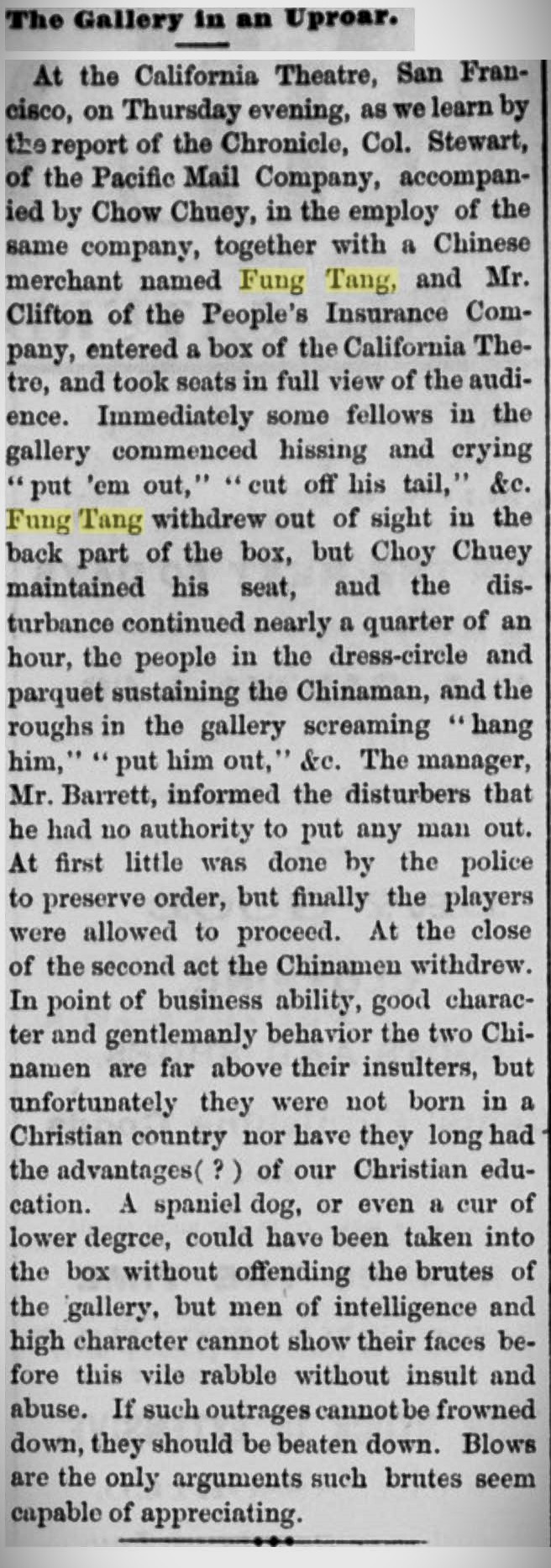
Clipping from the San Jose Mercury News, September 18, 1869 (vol. I no. 42)
Fung Tang’s transpacific success in San Francisco was hardly unique among the ranks of Chinatown’s early merchant class. He exemplified the business acumen of his fellow pioneering entrepreneurs and their establishment of transpacific trading posts in strategic locations.
Lai Chun-chuen and Chy Lung Co.
The story of the pioneer business of Chy Lung & Co. predates the history of San Francisco Chinatown itself, and its establishment spurred the rise of Chinatown’s first commercial strip, Sacramento Street (唐人街; canto: “Tohng Yahn Gaai”) or “Chinese Street.”

An enlargement of the stereograph taken by Carleton Watkins for the Thomas Houseworth & Co., and “[e]ntered according to Act of Congress, in the year 1866 by Lawrence & Houseworth, in the Clerk’s office of the District Court of the United States, for the Northern District of California.”
“Among the early Chinese settlers were merchants like Lai Chu[sic]-chuen,” the late historian Judy Yung wrote in her pictorial book, San Francisco’s Chinatown (published by the Chinese Historical Society of America). “Upon arrival in 1850, he opened Chinatown’s first Bazaar at 640 Sacramento Street, importing teas, opium, silk, lacquered goods, and Chinese groceries.”

"Chy Lung & Co., Sacramento St., San Francisco. 1796" c. 1866. Photograph by Carleton Watkins for his Watkins' Pacific Coast stereograph series (from a private collection).
Chy Lung’s founder, Lai Chun-chuen (a.k.a. Chung Lock), came to San Francisco in 1850 from Nam Hoi county. According to UC professor Yong Chen, the business founded by Lai and, his partners Xie Mingli, Fang Ren, Sheng Wen, and Chen Nu, appear in the earliest business directories for San Francisco. A “Chyling, china mer, 188 Washington” appears in the Parker directory for 1852-1853. The Colville’s directory of 1856 lists a “Chy Lung (Chinese) mcht, Canton Silk and Shawl Store, 166 Wash’n,” and the business would remain on Washington Street (moving to 612 Washington St. by 1858) until 1863 when it relocated to 642 Sacramento Street. By 1865, the Chy Lung & Co. had either expanded or taken over the address of 640 Sacramento Street.
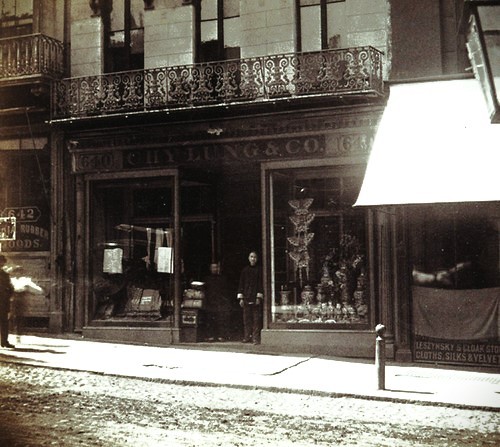
Portion of the stereograph “No. 391 Chinese Store. Chy Lung & Co.,” c. 1866. Published by Lawrence & Houseworth (from in the collections of the Society of California Pioneers, Wells Fargo Corporate Archives, and the Library of Congress).
“He imported Chinese prefabricated houses and cargoes of Chinese goods, teas, silk, lacquer and Porcelain wears, and even opium,” historian Phil Choy wrote. “The drug that made American merchants millionaires in the China trade now found its way to California for both the Chinese and American markets Chy Lung was one of only two Chinese businesses at the time that advertised in an American newspaper, the Daily Alta California.”
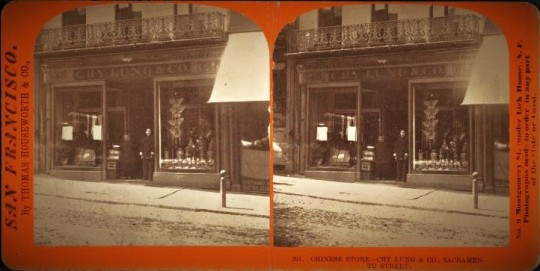
“No. 391 Chinese Store. Chy Lung & Co., Sacramento Street.” c. 1866. Published by Thomas Houseworth & Co. (from in the collection of the New York Public Library).
Lai Chun-chuen is remembered not only for his business acumen but also as the principal author of the objections to the anti-Chinese movement in California and plea for civil rights as published in the pamphlet, Remarks of the Chinese Merchants of San Francisco, upon Governor Bigler’s Message, and Some Common Objections (San Francisco: Whitton, Towne, 1855).
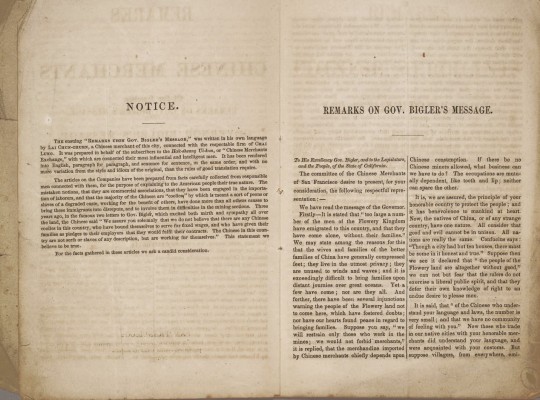
The preface to Remarks of the Chinese Merchants of San Francisco upon Governor Bigler’s Message, and Some Common Objections of 1855 (from the collection of the Bancroft Library). The second line of the first paragraph identifies Lai Chun-chuen as “a Chinese merchant of this city, connected with the respectable firm of CHAI LUNG.”
Chy Lung & Co. continued to play a leading role in the Chinese merchants exchange until Lai Chun-chuen’s death on August 30, 1868. The business remained a fixture of the Chinatown business community for the rest of the 19th century, and it adopted the new communications technology of the telephone, as shown by the Pacific Telephone directory for the Chinese Exchange in 1902.

The listing for Chy Lung & Co. as it appeared in the Wells Fargo directories of Chinese business for 1878 and 1882.
The Chy Lung & Co. business, and others established by Chinatown's merchants, soon comprised a source of both tangible and symbolic power within the rapidly growing Chinese community in the American West. As the Chinese immigrant population swelled, businesses catering to their specific needs diversified and expanded. A hierarchical structure emerged, influenced by both economic factors and the district of origin. The wealthier Sanyi individuals typically presided over larger, commercially successful enterprises, including import-export firms. Those from the Nanhai District dominated the men's clothing and tailoring sector, as well as butcher shops. The neighboring Shunde District populace exercised control over overalls and workers' clothing factories.
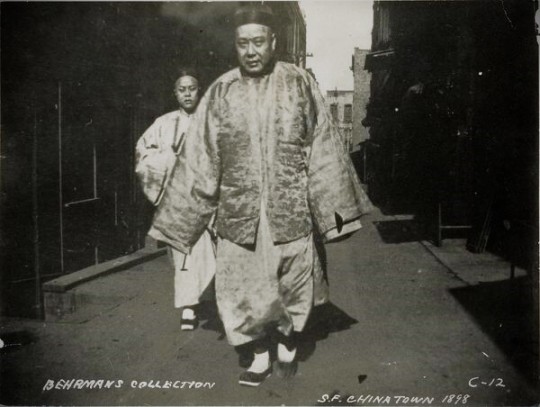
“S.F. Chinatown 1898 C12”. Photographer unknown (from the Martin Behrman Collection of the San Francisco Public Library). A well-attired merchant and possibly his son walk south on Spofford Alley from Washington to Clay Street.
Meanwhile, Chinese hailing from the Zhongshan District, which represented the second-largest Chinese population in California, were prominent in the fish and fruit orchard businesses, as well as in the production of women's garments, shirts, and underwear.
"Quan Quick Wah"
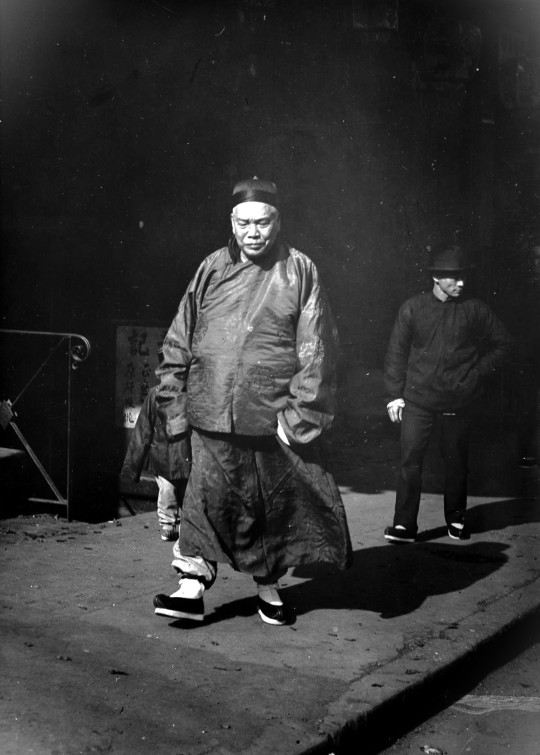
“Merchant and Bodyguard” c. 1896 – 1906. Photograph by Arnold Genthe (from the collection of the Library of Congress). A descendant of the large, confident man shown in traditional robes identifies him as San Francisco merchant “Quan Quick Wah.” Based on other photographs of this Chinatown location, the pair appears to be walking on the west side of Waverly Place toward its intersection with Clay Street. In his book about Genthe’s Chinatown photographs, historian Jack Tchen wrote about this imposing figure followed by a bodyguard as follows: “The powerfully built man dressed in traditional silk robes has been described as a tong leader. Whether he was a tong leader, a wealthy merchant, or both, his dress and carriage convey a strong presence. Tong leaders came to rival the power of wealthy merchants. The man following the merchant or tong leader is said to have been his bodyguard, protecting him from the attack of a rival tong. In the photograph the two are passing under ornate cloth lanterns that indicate a pawnshop business.”
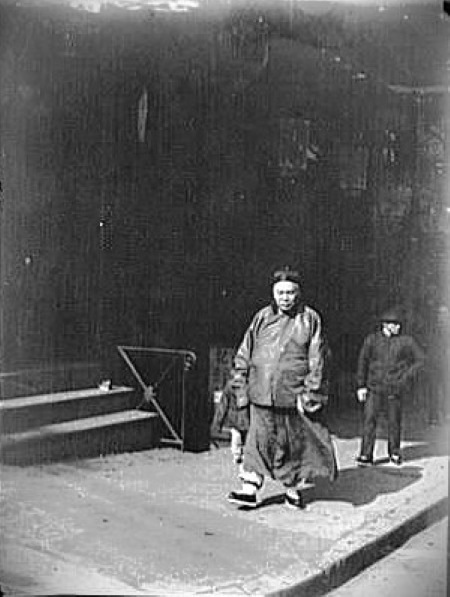
"Merchant and Bodyguard” c. 1896 – 1906. Photograph by Arnold Genthe (from the collection of the Library of Congress). This full photograph in the Library of Congress shows that Genthe’s image fortunately included a portion of the sign for the entrance to a basement restaurant. The signage (which appears in other photographs of this area), indicates that the merchant and bodyguard were photographed walking on the west side of Waverly Place (at about no. 23 and 25 Waverly) and toward the southwest corner of its intersection with Clay Street. Tchen’s guess that the background store frontage was a pawnshop is probably correct, as the “Qung Hing Art Co.” pawnshop occupied space at 25 Waverly during the 1890s. The headquarters of the merchant-controlled, Ning Yung district association was located at 23 Waverly.
Yee Ah-Tye
In old Chinatown, merchants’ personal use of bodyguards or alliances with fighting tongs were common. The organization and fragmentation of district and clan associations, along with sharp business competition, often placed lives, as well as livelihoods, at risk. For example, the Kong Chow association traced its origin to about 1853, when the influential community leader, Yee Ahtye (a.k.a. “George Athei”) persuaded members of his Yee clan of Sunning, which had remained in the Sze Yup Co. (after a number of clans split off to organize today’s dominant Ning Yung Association), to finally secede. The action by the Yee clan was joined by clans from Hoiping and Enping counties after a dispute over the presidency of the Sze Yup Co. in 1862. The resulting new association, the Hop Wo, soon challenged the merchant Ah-Tye for the custody of a piece of land on which Ah-Tye had allowed the Sze Yup Association to build a headquarters building. Yee eventually deeded the land to a new Kong Chow Association, which his fellow Sunwui merchants founded in 1866. The dispute over this property raised to such a level that Yee and his associates were compelled to organize a secret society, the Suey Sing Tong, to protect the asset and enforce his decision.

Portrait of Yee Ah-Tye (courtesy of the Chinese Six Companies). Yee was an elite merchant of Chinatown and was considered a co-founder of the Suey Sing Tong.
Born around 1829 in Guangdong province, Yee Ah-Tye had arrived in San Francisco just before the gold rush at around 20 years old. In spite of his humble beginnings, Yee had learned English in Hong Kong and swiftly ascended to a position of authority within the influential Sze Yup [pinyin: "Siyi"] Association. The Sze Yup Association, along with similar Chinese district associations, played a crucial role in assisting newly arrived Chinese immigrants during the 19th century. The organizations provided accommodation and job opportunities.
Aside from his many business accomplishments, Yee famously cross paths with the legendary, San Francisco madam Ah Toy. The conflict arose when Ah Toy accused Yee of demanding a tax from her prostitutes on Dupont Street. Despite her origins in China, Ah Toy had by then lived in America for three years and become familiar with its legal system. She boldly threatened to take legal action against him, a move she would not have dared to undertake in China.
The August 1852 report in the Daily Alta California newspaper highlighted Ah Toy's shrewdness, emphasizing her knowledge of living in America and her ability to navigate the legal system. She resided close to the police station, fully aware of where to seek protection, having faced legal proceedings herself numerous times. The reporter gleefully suggested that Yee use caution about overstepping his authority, warning that he might lose his dignity and end up in custody.
A year later, Yee faced legal trouble himself, being arrested for assault and grand larceny. The San Francisco Herald alleged Yee “inflicted severe corporeal punishment upon many of his more humble countrymen … cutting off their ears, flogging them and keeping them chained for hours together.”
After moving to Sacramento in 1854, Yee also relocated his business activities in 1860 to La Porte, California, where hydraulic and drift mining operations for gold occurred. Yee acquired a partnership in a store called Hop Sing & Company which supplied merchandise and Chinese contract laborers. By 1866, it was the richest Chinese store in that town, with a value of $1,500 (about $36,000 in 2005 dollars).
According to one of his descendants, Lani Ah Tye Farkas, the pioneer Yee Ah Tye reportedly lived thirty-four years in La Porte as a successful merchant, running the Hop Sing and Company store and representing the Chinese community in the area. He had three wives and four children, three of whom were girls. Unlike most other Chinese fathers at the time, he invested in the education of his daughters – he even bought a piano for his youngest daughter, Bessie, who became an accomplished pianist. As a leader in the Hop Sing Association, he founded a small hospital to serve the elderly Chinese men of La Porte.
“The temple ruins at San Francisco's Lincoln Municipal Park Golf Course was once part of the Lone Mountain Cemetery, a gift of Ah Tye,” Lani Ah Tye Farkas wrote in 2000. “Other glimpses of his life in America can be seen in deeds, mining claims, tax assessments, newspaper articles, and land that he once owned. Yee Ah Tye's legacy, however, is in his descendants. Many Chinese with common last names like Chan, Lee, and Wong may have no relationship with one another. However, the descendants of Yee Ah Tye have borne his unique last name through six generations, in the words of the Yee family genealogy, ‘spreading like melon vines, increasing continuously’” Yee died in 1896. (see: https://scholarworks.calstate.edu/downloads/pc289j76z)
Contract Labor
At the lower end of the business hierarchy, the Siyi or Four District residents comprised the largest and least affluent group of Chinese immigrants. They typically occupied occupations such as laundries, small retail shops, and restaurants and the bulk of the laborers in the contract labor system.
In the period preceding the Civil War, there was a concerted effort by certain individuals to introduce contract laborers into the United States. A letter penned by C. V. Gillespie to Thomas Larkin on March 6, 1848, sheds light on this initiative. Gillespie expressed a keen interest in the idea of bringing Chinese emigrants to the country, suggesting that a variety of skilled workers and laborers could be sourced:
"One of my favorite subjects or projects is to introduce Chinese emigrants into this country,… Any number of mechanics, agriculturists and servants can be obtained. They would be willing to sell their services for a certain period to pay their passage across the Pacific…."
The practice of importing contract laborers to the United States began in the late 1840s and continued through the 1850s. However, enforcing labor contracts proved to be a challenging endeavor on American soil. A case in point involved an Englishman who, upon bringing fifteen Chinese laborers to the country bound by a two-year contract, found that they immediately reneged on their agreement upon arrival. Authorities, at the time, were reluctant to intervene in such disputes.
In 1852, Senator George B. Tingley introduced a bill in the California State legislature aimed at legalizing and facilitating the enforcement of contracts allowing Chinese laborers to sell their services to employers for periods of up to ten years at fixed wages. This proposal, however, faced significant public backlash and was ultimately defeated after a heated debate. The subsequent year saw members of Chinese companies admitting that they had initially imported workers during the early years of the Gold Rush. Yet, due to unprofitability and difficulties in enforcing labor contracts, they abandoned this practice.
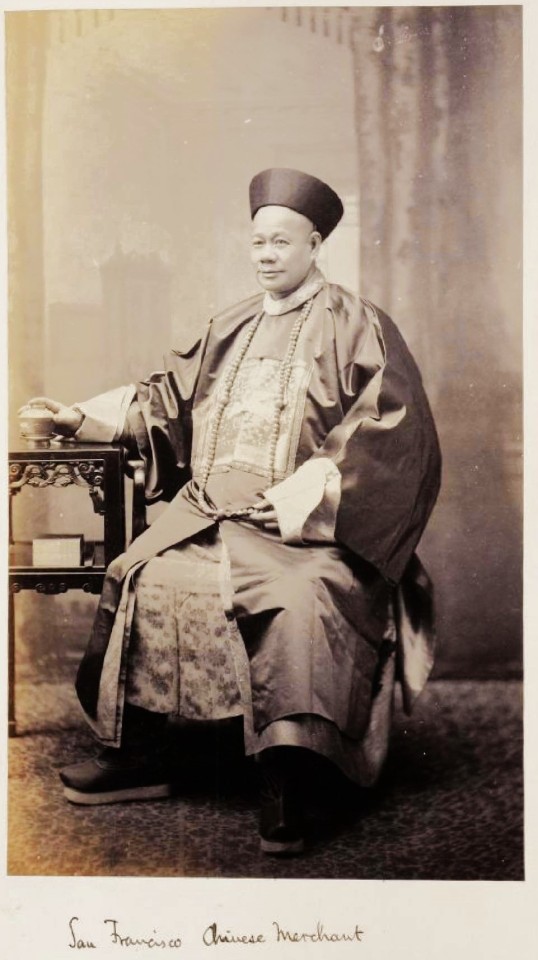
“San Francisco Chinese Merchant” no date. Photographer unknown, possibly by Ann Ting Gock (from a private collection). This rare and unusual image suggests that the individual might not have been a mere merchant at all, but a member of the Chinese consular staff. He is seen wearing his 清代官帽 (canto: "ching dai gwun moe") or official's headwear. The Qing official headwear or Qingdai guanmao (Chinese: 清代官帽; pinyin: qīngdài guānmào; lit. 'Qing dynasty official hat'), also referred to as the “Mandarin hat” in English, is a generic term which refers to the types of guanmao (Chinese: 官帽; pinyin: guānmào; lit. 'official hat'), a headgear, worn by the officials of the Qing dynasty in China. The merchant is attired in a "changshan" or "changpao" or long robe. The robe worn in the photo was derived from the Qing dynasty-period "qizhuang" (the traditional dress of the Manchu people). Changshan were, and are, traditionally worn for formal pictures, weddings, and other formal Chinese events.
Credit-ticket System
Beyond the initial years, it became widely acknowledged that Chinese immigrants arrived in the United States voluntarily, free from any servile contracts or duress. Many emigrants either financed their own passage or received assistance from relatives and friends already residing in California. The prevailing method for the majority of Chinese immigrants during the 19th century was the credit-ticket system. Under this system, an emigrant would receive financial support for their passage in a Chinese port. Upon reaching their destination, the emigrant was expected to repay this debt using their future earnings. It is important to note that this system differed from the contract labor arrangement, where laborers were bound to serve for a specified duration.
The precise origins of the credit-ticket system remain uncertain. However, merchant brokers in Hong Kong were established to provide advanced passage funds, approximately forty dollars, to the emigrants. Corresponding entities in the United States were responsible for collecting these debts and aiding the newly arrived immigrants in finding employment.

Two merchants with pipes. No date, photographer unknown (from a private collection).
The stores and offices that the merchants of Chinatown had opened starting in the mid-19th century became the basis of real and symbolic power in the growing regional community of Chinese living in the American West. That power, including the ability to mobilize for social change within the narrow role afforded Chinese in the society, manifested itself in the family and district associations headed by local merchants.
“The merchant class has traditionally been the one sector of Chinese society able to foster unity and bring about social change,” wrote historian Thomas W. Chinn about the role of the merchant class in San Francisco Chinatown (and beyond). “The merchant-directors of the Chinese Consolidated Benevolent Association must be well-established businessmen in the local community as well as outstanding members of their own family associations. They have already played a leading role in their own social circles before becoming merchant-directors, and they enjoy a great deal of respect. . . Thus the friendly corner grocer may simultaneously be the president of his family association and his district association as well as a merchant-director.”
Lew Kan
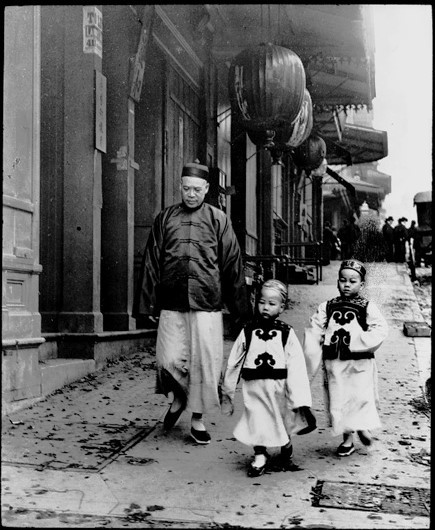
“Children of High Class” c. 1900. Photograph by Arnold Genthe (from the Genthe photograph collection, Library of Congress, Prints and Photographs Division). Merchant Lew Kan (a.k.a. Lee Kan) walking with his two sons, Lew Bing You (center) and Lew Bing Yuen (right). According to historian Jack Tchen, “Lew Kan was a labor manager of Chinese working in the Alaskan canneries. He also operated a store called Fook On Lung at 714 Sacramento Street between Kearney [sic] and Dupont. Mr. Lew was known for his great height, being over six feet tall, and his great wealth. The boys are wearing very formal clothing made of satin with a black velvet overlay. The double mushroom designs on the boys’ tunics are symbolic of the scepter of Buddha and long life.” The photograph appears to have found the trio walking down the south side of Sacramento Street below Dupont Street.
By the time photographer Arnold Genthe had photographed merchant Lew Kan and his two sons on Sacramento Street (as well as two other earlier photos of their four sisters in Portsmouth Square), Lew had already attained legendary status as one of Chinatown’s leading merchants. Born in 1851, Lew entered the US in 1866.
Author Roland Hui (in his biography of pioneer Chinese American industrialist Lew Hing), wrote about Lew Kan and his dry goods business called Lun Sing & Co. at 706 Sacramento Street as follows:
“He started Lun Sing, one of the oldest businesses in Chinatown, around 1867, a year after he immigrated to the U.S. In 1896, the business gained notoriety by harboring a young Chinese revolutionary named Sun Yat-sen during his first visit to the continental United States. Sun advocated overthrowing the Qing monarchy and establishing a Chinese republic. His ideas were too radical for the politically uninitiated Chinese community. Kang Youwei, the architect of the ill-fated “Hundred Day Reform” in China in 1898, favored establishing a constitutional monarchy around Emperor Guangxu. Forced into exile after the power-hungry Empress Dowager crushed his reform, Kang launched the Chinese Empire Reform Association, also known as Baohuanghui (Save the Emperor Society), the following year in Victoria, Canada. Baohuanghui quickly gained widespread support among overseas Chinese since the idea of having an emperor at the top of the social order who ruled with the Mandate of Heaven had been ingrained in the Chinese psyche for thousands of years. The San Francisco Baohuanghui chapter was founded in 1899 at 146 Waverly Place. Lew Kan supported Kang’s political agenda despite having met Sun several years earlier, and in 1901 became the president of the San Francisco chapter of Baohuanghui. Many scholars observed that Baohuanghui was the first organization that evoked the patriotic sentiments of overseas Chinese. And when Liang Qichao, Kang's most famous student, stopped over in San Francisco during his 1903 America tour, thousands of Chinese flocked to listen to his speeches. As the man who organized these community-wide activities, Lew Kan's stature and influence in San Francisco Chinatown must have been substantial. In addition, he was one of the wealthiest Chinese merchants, reportedly owning several general merchandise stores with an estimated net worth of $2 million. That was an astronomical sum in those days. In addition, he was a director of the Kong Chow Company, a district association representing Xinhui."

New-Year's Calls Among the Merchants" illustration from the article "The Sixth Year of Qwong See," published in Harper's Magazine, December 1880. The image may have captured merchants greeting each other at the Chinese Merchants Exchange on Sacramento Street perhaps on or about the fourth day of the Chinese New Year holiday period when business traditionally returns to normal.
Decline of Merchant Influence
The organizational expression of Chinatown’s merchant elite, the Chinese Six Companies, wielded considerable authority within San Francisco and beyond. The Six Companies and its constituent district associations comprised the quasi-government of Chinese America, offering social services, mediating disputes, and representing the community's interests to external forces. With the enactment of the Chinese Exclusion Act in May 1882, their grip on power began to weaken.

Portrait of a merchant with fan and scroll. No date, photograph possibly by Shew’s studio (based on the detail of the end-table), from the collection of the Stanford Libraries.
The decline of the Six Companies’ influence can be attributed to various reasons. One significant factor was their inability to adapt swiftly to the evolving socio-economic landscape within Chinatown. As the community faced new challenges, including the punitive extension of Chinese exclusion with the Geary Act of 1892, the Six Companies struggled to effectively navigate these changes, leading to a loss of faith among the populace in their ability to address emerging issues.
The Geary Act of 1892 extended and strengthened the Chinese Exclusion Act of 1882, requiring most Chinese Americans – native and foreign-born -- to carry an internal passport in the form of certificates of identity or face arrest and deportation. It intensified discriminatory measures against the Chinese community, fostering widespread discontent and resistance.
In response, the Six Companies initiated a national boycott against the Geary Act. The boycott aimed to unify Chinese immigrants and their supporters across the United States, urging them to refuse compliance with the law as a form of protest. It gained substantial momentum, with significant participation from Chinese communities in various cities, voicing opposition to the Act's discriminatory provisions.
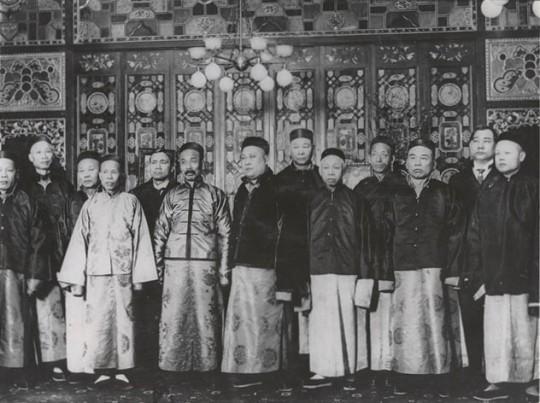
The board of directors of the Chinese Six Companies, no date. Photographer unknown (from the collection of the Bancroft Library). Based on the screen panels in the background (which remain in the Six Companies’ meeting hall at 843 Stockton Street in San Francisco), the photo appears to have been taken after 1906.
Despite its initial vigor, several factors led to the ultimate collapse of the national boycott against the Geary Act. First, the federal government intensified its efforts to enforce the Geary Act. Authorities conducted widespread raids and inspections, threatening deportation and imposing harsh penalties on those failing to comply. The fear of reprisals and the potential disruption to livelihoods coerced many Chinese immigrants into reluctantly acquiescing to the Act's demands.
Second, the broader American society exhibited little sympathy or support for the Chinese community’s plight. The prevailing anti-Chinese sentiment in the country and the lack of significant political backing from other institutions diminished the effectiveness of the boycott. Without widespread solidarity, the Chinese American community struggled to sustain its resistance.
Finally, the decision by the US Supreme Court in Fong Yue Ting v. United States, 149 U.S. 698 (1893), dealt a major legal setback to Geary Act resistance and undermined the credibility of the Six Companies. The decision validated the Geary Act and created an environment of fear within the Chinese American community. The inability to overturn the Geary Act by legal means diminished trust in the Six Companies’ capacity to protect the community's interests.

Photograph of a merchant from Chinese Business Partnership Case File for Quong Lee Company, c. 1896. Photographer unknown (from the files of the Department of Justice, Immigration and Naturalization Service, San Francisco District Office). The immigration investigative case file indicates that the individual in this photo was certified as a business partner and a "merchant" who was “able to travel to and from the U.S. as a ‘Chinese subject of exempt class’ under the ‘Chinese Exclusion Acts’ (1882-1943).” The Quong Lee & Co. (a.k.a. Quong Lee, Quong Lee Sing) operated what business directories from 1875 to 1905 variously described as a “tailor,” “general merchandise,” “clothing,” and “dry goods” business continuously at 828 Dupont Street. By the time this merchant sat for his photo in 1896, the national boycott led by Chinese merchant organizations against the Geary Act of 1892 had collapsed, and studio portraits such as this became an essential pieces of evidence to support applications for the coveted merchant exemption from the extended Exclusion Act.
This heightened sense of vulnerability played into the hands of tongs, which, capitalized on the weakened merchant community. Amidst the faltering influence of the Six Companies, tongs emerged as influential entities that would come to dominate Chinatown’s socio-political structure and shape mainstream society’s perceptions of the Chinese community for the next three decades.
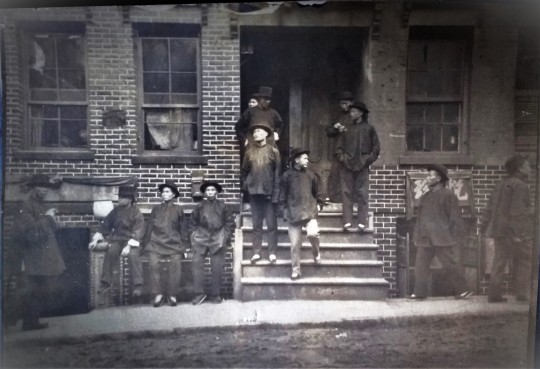
“High-binders Retreat” no date. Photograph by Goldsmith Brothers (from the Cooper Chow Collection of the Chinese Historical Society of America). Tong members at ease in front of their fraternal order's headquarters.
Tongs, in contrast to the Six Companies' diplomatic approach, adopted a more assertive stance in responding to discrimination and persecution faced by the Chinese community. Their readiness to protect their members (which also included merchants), and defy external pressures resonated with many disillusioned residents.
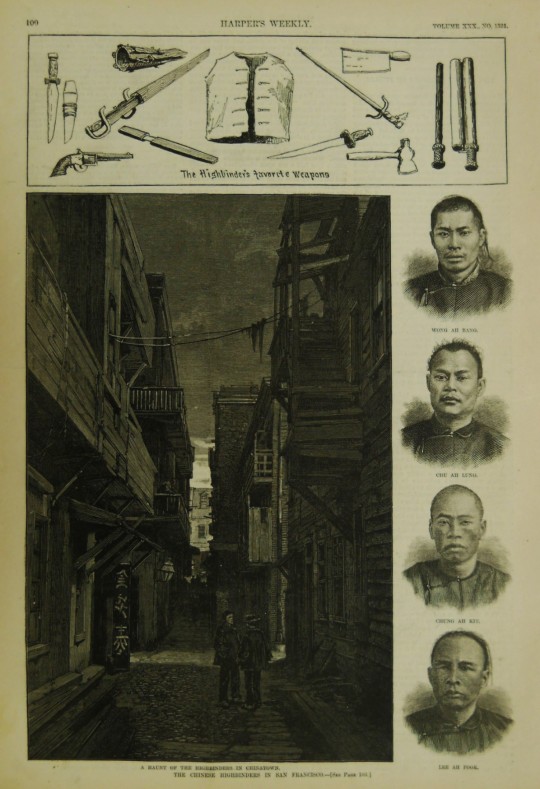
“A Haunt of the Highbinders in Chinatown.” Harpers Weekly, February 13, 1886 (from the collection of the Bancroft Library).
Moreover, the tongs during this period had begun to diversify their activities beyond traditional, illicitl sources of income such as prostitution, gambling, and drug distribution. Tongs began engaging in both legitimate businesses, including labor contracting for the Alaskan canneries. This diversification allowed them to accumulate resources, expanding their sphere of influence within Chinatown and beyond as alternative community governance structures, while still reserving often violent means to protect their interests.
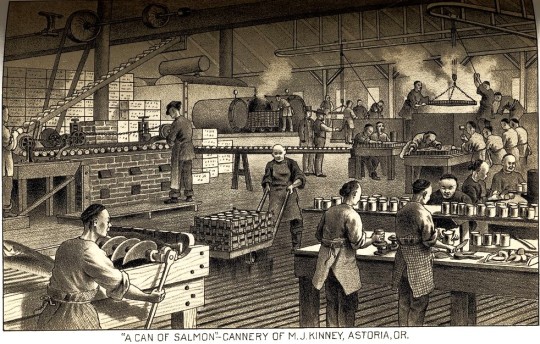
Chinese salmon cannery works in Astoria, Oregon, c. mid-1880s. Drawing from West Shore, June 1887, from the Special Collections, University of Washington). The early 20th century would be marked by violent struggles between tongs such as the Suey Sing and Bing Kung for control over the labor contracting business for the canneries.
The ascendancy of tongs at the turn of the century coincided with the republican movement in China. Historian Phil Choy wrote that the Chee Kung Tong, the original triad society, had been evolving in response to revolutionary movements in mainland China:
“Chee Kung Tong returned to its lofty political ideologies in 1900 when both Kang Yu-wei’s Reform Party and Sun Yat-sen’s Revolutionary Party sought its assistance. Originally the Chee Kung Tong supported Kang Yu-wei, but as Dr. Sun’s ideology gained popularity, the Chee Kung Tong, switched allegiance. When in 1904 immigration officials did not allow entry to Sun, the leader of the Chee Kung Tong, Wong Sam Ark, and the Tong’s attorney Oliver Stidger, along with Reverend Ng Poon Chew and Reverend Soo Hoo Nam Art, worked successfully for his release. Sun stayed at the Chee Kung Tong headquarters and used the society’s newspaper, the Chinese Free Press, to propagandize his revolutionary cause. Accompanied by Wong Sam Ark, Dr. Sun went on a nationwide tour to generate support and contributions.”
The tongs’ economic power and their active involvement in fundraising for the republican movement not only showcased their financial strength but also demonstrated their ability to wield influence as an overlapping and sometimes counter-force with the merchant elite. This dual role as (1) economic powerhouse within the local community, and (2) significant contributor to a revolutionary cause overseas underscored their influence. The growth of that influence came at the expense of the merchant elite in shaping both local and international affairs.
Merchants, however, would continue to exert influence through clan organizations, tongs, business associations, Nationalist Party of China chapters, and Chinese “consolidated benevolent associations” in San Francisco Chinatown and communities across North America through the exclusion era, war, and peace.
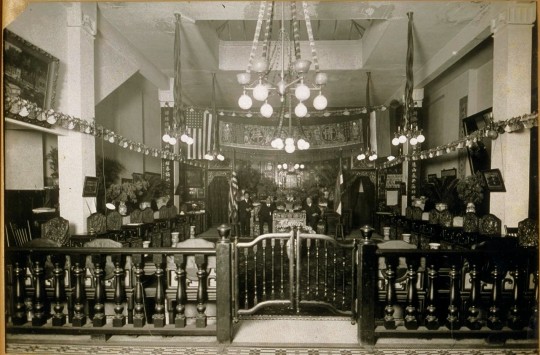
The meeting hall of the Chinese Six Companies, c. 1920 (by then incorporated as the Chinese Consolidated Benevolent Association) at 843 Stockton Street in San Francisco. Photographer unknown (from the Jese B. Cook collection of the Bancroft Library).
Chinatown's merchant community would face new challenges to their capacity as civic leaders when the political center of gravity across US Chinatowns would shift again in the last quarter of the 20th century.
[updated 2023-12-28]
#Chinatown merchants#Sing Man#Choy Chew#Chinese Merchants Exchange#Fung Tang#Lai Chun-chuen#Chy Lung & Co.#Yee Ah-Tye#Chinese Six Companies#Kai Suck#Ann Ting Gock#Lew Kan#Chee Kung Tong#Quong Lee & Co.
1 note
·
View note
Text
et oravit - destiel fic
Title: et oravit Pairing: Castiel / Dean Winchester Rating/Length: G / 2k Summary: Dean has a lot of feelings about Cas being back.
[AO3]
It’s one thing that Cas is back (flesh blood bone and still full of grace); it’s another that he’s back. Back home. A body in the world again.
Dishes in the sink, clothes dumped next to the ancient washer instead of inside, the scent of cheap shampoo slinking into every corner of the bunker. He’s home, in Dean’s space, and Dean doesn’t know where to go from there.
***
Dean doesn’t know what he expects to happen, after Jack sets the world to rights, after everyone comes back to them. Nearly everyone.
It takes Cas longer, much longer to walk into the library on a misty morning than Dean can almost bear.
And Dean had waited, checking every cellphone he owned for a call, a text; standing in the open doorway and staring at the stars for a sign; checking every blog, every source, every radio for a word of anything out of the ordinary. Even giving that goddamn telescope-geoscope fucking thing a few kicks in hopes it might let him see more, to look a little farther. But there was only the weight of disappointment and hopelessness to be found.
And then Cas is there, edging into the library almost furtively, as though unsure of his welcome. As if the front door hadn't just opened for him.
Sam is the first to notice him - Dean too drunk to read the book on metaphysical translocation in front of him, let alone spot the reappearance of the only thing that mattered. Matters.
“Cas!” Sam shouts, shoving out of his chair so quickly it clatters to the floor and spins three feet away. Cas disappears behind Sam, caught up in a hug so unyielding it might have broken a regular man. But Cas has never been a regular man.
“Hello, Dean,” Cas says, voice as low as ever, full of the weight of the settled universe.
Dean stands - barely - legs weak and knees shaking. Unsure of his own sight, swimming in a week’s worth of liquor. “Cas?”
And then he pukes on the floor.
***
The days pass, slowly and too fast all at once. Morning, noon, and night sliding around the clock. Days of Cas living in the bunker full time, sleeping in his old room, walking around with bedhead and a frown before coffee. He eats Dean’s cooking with enthusiasm and puts his dishes in the sink without rinsing them. He wears sweatpants and doesn’t turn off the lights when he leaves a room. He smells like sparking ozone and drugstore soap and it sets Dean’s nerves alight. Every minute, every day.
He is safe and alive, present and real and solid. A human body full of grace. Unshackled from Heaven and Chuck and choosing the bunker all the same. Choosing Dean.
Dean watches him. He watches from doorways and gives him space. Gives himself space, really. He thinks he’s owed it. Cas’ words tumble around his brain, replayed over and over, as soon as Dean wakes until he falls into restless sleep.
I love you.
Just him, Cas had said. Only to him. In the final moments of his last life. No guile. No qualifications. Just a fact. A basic truth.
And Dean knows it. A year ago, six months ago, a different Dean might have pushed it away, might have denied it, might never have thought about it again. Locked it away with the other horrors and nightmares that scar his life. But he’s not that man anymore, hasn't been that man in a whilte. He’s died and returned and survived too many times - too many lives - to go back to that place.
But that doesn’t mean he knows where to go from here, doesn’t know what to do with it.
He had meant to say me too. He had meant to say I love you more than death. He had meant to say anything at all, but then Cas was gone and the words sat like stale whiskey and broken hope in his throat.
And now he can’t say anything at all.
***
Dean stares blankly at his keyboard, chin resting on his palm. Ostensibly he’s looking up how to grow vegetables in Kansas, but really he’s listening for Cas.
“You should talk to him,” Sam says. Not for the first time and certainly not the last.
“Shut up,” Dean responds, thoughtlessly. It’s a reflex. Defensive. And he knows it, but it’s the easiest thing to say.
Sam doesn’t even look up from his laptop. Eileen is next to him, leaning her cheek against his shoulder as they check the wires for hunts. Jack may have fixed the earth, but this earth still comes with monsters. Fixed doesn’t mean perfect, and it doesn’t mean paradise.
Eileen’s hands move in a quick burst that makes Sam laugh.
“I don’t know what that meant but I know it ain’t nice,” Dean grouses. He’s been studying ASL, but it’s slow going. Mostly because he’s too distracted by the worn and dog-eared copy of Dante’s Inferno Cas left in the den, and the coffee cups in every room, and the trench coat draped over the back of the chair in Cas’ room Dean can see whenever he walks past the open door.
Cas had returned wearing it. The first one. The one Dean sees him in when he closes his eyes, when he dreams late into the morning. Cas had returned as Dean remembered him the clearest: bright-eyed, striking, too beautiful to be human. No black goo dripping from his hair, no wounds marring his remade flesh, no blood staining the ground. Just Cas. A fucking angel.
“Jack,” Cas had said with the slightest shrug when Dean and Sam had continued to stare. As if that was enough to explain the pure miracle of his return. Maybe it was.
And now, now Dean spends the days tracking Cas’ movements around the bunker, making sure he’s eating enough, that he remembers how to use the remote control, that he’s still there.
I love you.
It haunts Dean at two in the morning when he thinks he can hear Cas shifting restlessly in his own room. And it lifts him in the afternoon when Cas offers him the sweetest, toothiest smile in the galaxy at the coffee Dean offers him without being asked.
“Don’t mention it,” Dean grumbled. Cas didn’t. But he smiled.
“If you don’t talk to him,” Sam continues, still not looking at Dean. He doesn’t have to. “I will.”
“You won’t.” It’s not a threat and Dean doesn’t have it in him to try and make it one.
Cas shuffles into the library, yawning and cracking his neck. Dean’s heart pushes against his ribcage at the sight of him, loud enough he’s sure Cas can hear it. It should embarrass him, should terrify him. And it does. But it also thrills him, because it’s allowed. Cas said it was.
“Hey Cas,” Sam greets.
“Sam,” Cas nods. He looks at Eileen and signs as he speaks, “Hi, Eileen.”
And then his gaze lands on Dean.
Dean feels it in his toes. His gut. The ends of his hair. It’s the same crackling intensity as when Cas first walked through the door of a dark barn in the middle of nowhere, the lights bursting overhead at the sheer power of him. The grace he somehow contains in the remade body of an accountant.
Dean doesn’t see Sam and Eileen get up, but he notices it when they’re gone.
Bastards, he thinks, but he’s grateful nonetheless. He doesn’t need an audience for this.
Cas is wearing his old slacks, but a plain white undershirt that might have belonged to Dean once. It makes Dean warm all over, makes his chin slip off his palm. Makes him want to run from the room and leap into Cas’ arms.
“Morning, Dean.”
Dean has to clear his throat before he can respond. “Hiya, Cas.”
There’s something in Cas’ eyes, maybe. Dean isn’t sure. It’s too hard to look at him for too long, even now. Maybe especially now, when it feels like Cas can ready his every thought.
Cas slides into Sam’s vacated chair and frowns at the laptop still open on the table. “Are we looking for a hunt?”
“Yeah, uh, Sammie thought he found something. A-”
“Vampire nest,” Cas finishes for him, still looking at the screen, tapping a few keys with his fingers. “in Canton.”
“Ohio?”
Cas grunts in assent. The furrow in his brow is so familiar Dean feels it in every one of his old, tired bones.
Dean picks at the knees of his jeans, shifts in his chair. Fights the urge to run. “Sam and Eileen can handle it,” he says. And they can, Dean knows it, they’re more than capable. But he could also use some time alone with Cas, just them, just enough to figure out what comes next without a peanut gallery watching his - their - every move.
Cas looks up, looks over the laptop at Dean, and his eyes are as piercing, as fathomless as ever. More human than ever. They hold Dean in place and draw him closer. “Yes, I imagine they can.”
Dean loses whatever he thought he might say next and lapses into hunched silence.
He knows what he wants, what he really wants. Cas in the bunker, in their home. Cas in the kitchen while he’s cooking breakfast, soft and sleepy at the table and willing to eat anything Dean rustles up. Cas leaving his dirty fucking socks in the laundry room and never putting the cap back on the toothpaste. Cas in his bed. Cas in his life like he was never supposed to be, but always has been. Defiant.
But what is he supposed to say? What does he do? Now. When the rush of fear and confusion and adrenaline has passed. Now, when it’s quiet in the bunker and so many of ties holding him - them - down have been cut loose.
Cas is there. Cas is home. And what is free will worth if he doesn’t use it?
Dean licks his lips, clenches his fists, takes a deep breath that does nothing to calm his heavy-racing heart.
“Me too,” he mumbles, staring at his own computer and seeing nothing.
I love you. I do. I love you. I have for longer than I know. Longer than God. I didn’t need you to die to realize it I already knew.
“I do, too,” Dean says, louder, clearer. His pulse is pounding in his ears so loud that if Cas responded he wouldn’t hear him.
When he drags his gaze up, Cas is looking right at him. Staring, really. At him, and not through him. But he must see Dean’s heart nonetheless - so visible it feels through his skin and bones.
Cas tilts his head, questioning, and Dean wants to strangle him. To kiss him.To ask him to marry him. He’s going to make Dean say it, say it out loud, and Dean can see what the rest of his life is going to be like in that moment.
“I do, too,” Dean says, louder now. Clearer. “I love you. You have to know that.”
A smile starts in Cas’ eyes and grows to his lips. “I did. I do.” It sounds like a prayer.
“Okay.” Dean ducks his head, his own grin threatening to completely overtake him. “Okay, then.”
He doesn’t hear Cas move, but suddenly there’s a hand on his shoulder and another under his chin, gently turning him and tilting his head up and they’re kissing. In the bunker, on earth. Not in a dream, not under possession. Just them. Just Dean and just Cas. Kissing soft and slow, knowing there is at least the rest of their lives ahead of them. And then whatever comes after.
“Okay then,” Cas parrots, still smiling against his lips, his fingers light against Dean’s jaw. “Okay.”
#destiel#destiel fic#supernatural#spn#deancas#emily writes fic#well I haven't used that tag in a fucking long time#please enjoy?#I forgot how much I love writing tbh
136 notes
·
View notes
Text
Recap/review 15.20: “Carry On”
I’ll warn you right now - I did not hate it.
THEN: Chuck loses. Jack is God. The Winchesters are finally free.
NOW: Friends, get ready for a whole lot of fan service in the next few minutes. It's like TPTB have been reading everything we say and giving us what we want.
As a song about "ordinary life" plays, Dean's retro alarm clock goes off at 8:00. He shuts it off and sits up so we can see he's wearing a henley shirt (fan service points: 1). As he stretches, he's greeted by Miracle the dog (fan service points: 2)! Who is apparently his dog and definitely not Sam's!
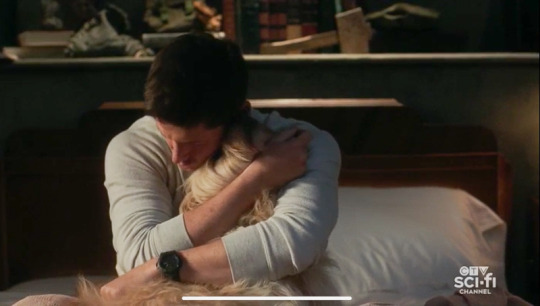
But it's okay because LOOK AT THEM.
Meanwhile, Sam is running (fan service points: 3) and enjoying the beautiful day. When he gets home, he cooks (fan service points: 4) the same dry scrambled eggs that Stevie made for Charlie. Dean wanders in, wearing the dead guy robe, just as two slices of toast pop out of the toaster. I am not giving the robe any points because I don't think it's anything we all publicly long for and get excited about when it comes up, but I am willing to consider any opposing arguments. Sam, wearing just a t-shirt (5 points), tells Dean "it's hot" and I say mmm, yes it is. Dean adorably burns his hands on the hot toast and then brushes his teeth. You know what, I think the robe deserves a point after all. We're up to 6.
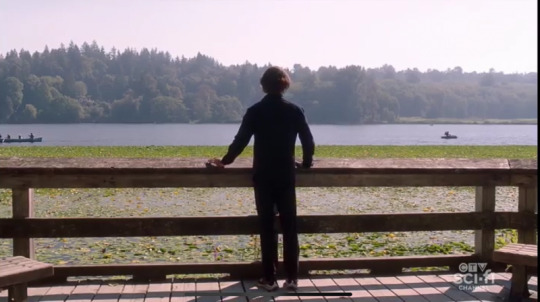
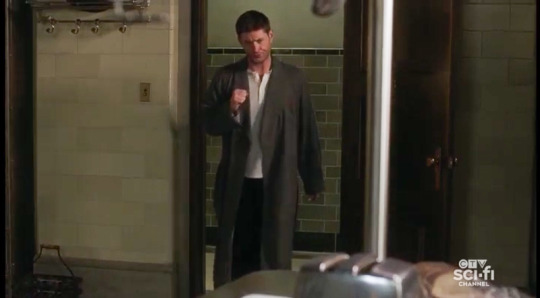
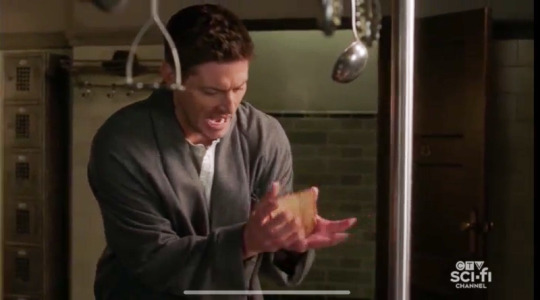
And we're not even two minutes into the episode.
And then they JUST KEEP COMING because Sam walks in, exposing his tattoo (7) because he's SHIRTLESS (8), scrubbing at his WET HAIR (9) with a towel, and I curse The Husband for deciding to watch with me because it means it would be kind of awkward to rewind and watch this a few more times. There's not even any dialog I can pretend I didn't catch.

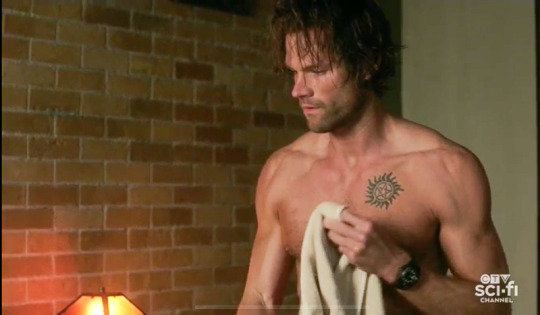
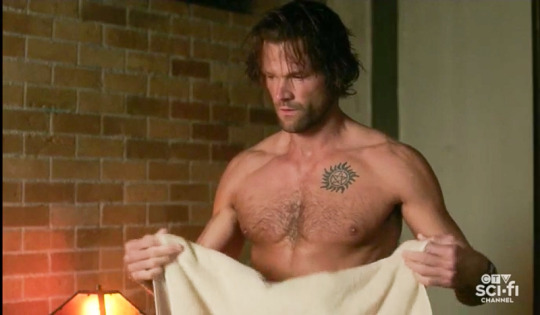
I was NOT PREPARED FOR THIS.
He pulls on the grey v-neck t-shirt of sex (10) and proceeds to carefully make his bed. Dean, meanwhile, kind of sloppily throws his bed together and calls it done. Domestic Winchesters for 11 fan service points, please. Part of me feels like Dean's messy room is OOC, considering how proud he was to have his own room in the first place. But then I have to consider the trunk of the Impala, especially when compared to the hyper-organized neatness of her trunk when Sam's all alone in Mystery Spot, and it feels right. (Why am I thinking about Sam being all alone in Mystery Spot? NO REASON, NO REASON AT ALL.)
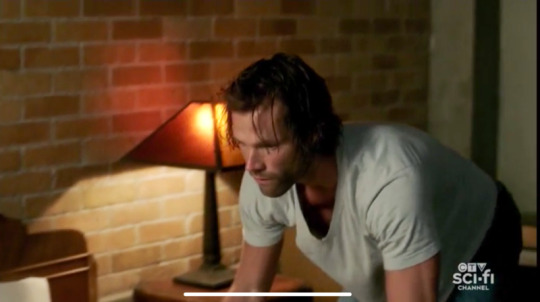
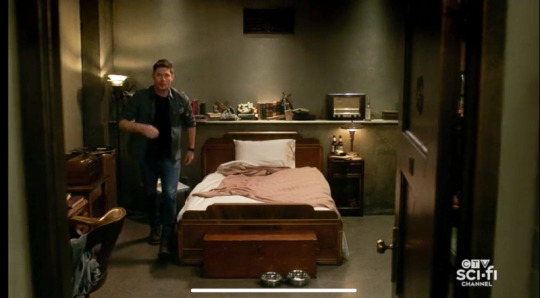
Sam's hair in his face while he makes his bed? Yes, please (12 points).
Dean washes the breakfast dishes (13), sneaking some leftover (because they were nasty) eggs to Miracle and looking around to make sure Sam doesn't see, because obviously Sam's going to be the one who doesn't want the dog to get table scraps. Sam put on a plaid shirt earlier, but we see him in the laundry room back down to one v-neck t-shirt (thank you Jack). He's reading as his laundry tumbles in the dryer, and he has to kick the dryer once to stop it from making noise, which I guess is why he's in there babysitting it. I keep reading on Tumblr that people want "at least one laundry scene," as if that didn't exist in The Monster at the End of This Book, but here's your laundry scene, friends. You were right to want it; it is marvelous (14).
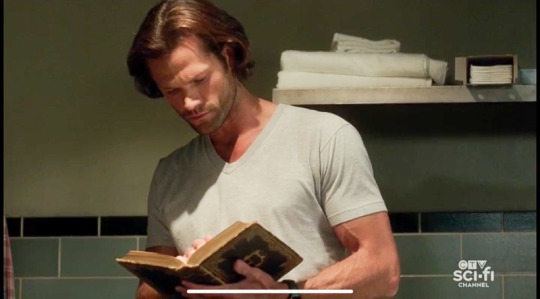
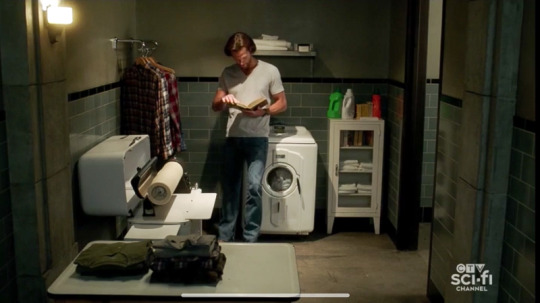
Just look at that collection of plaid shirts and tell me it doesn't make you happy.
Dean times himself assembling a gun, complete with plenty of hand closeups (15) and then sits in the library with Miracle, scratching his ears (Miracle's, not his own) and apparently looking for a case. Sam comes in and joins them. He hasn't found anything, but Dean gets a serious look on his face and says "I got something."
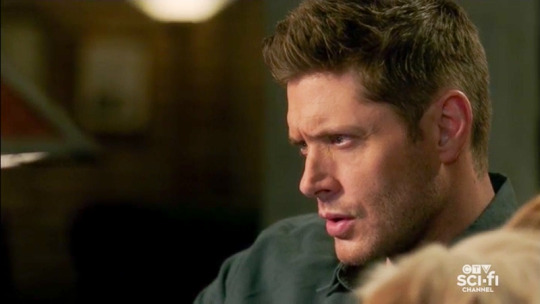
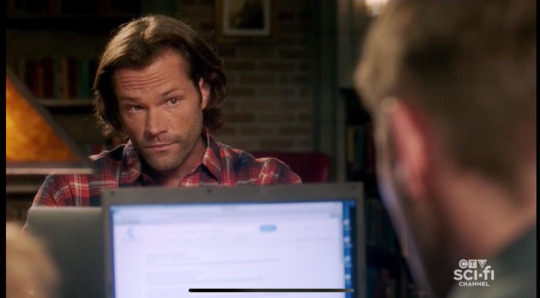
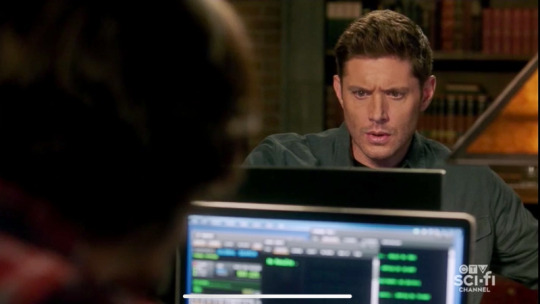
Spoiler alert: It is my heart.
Title card!
The Impala pulls to a stop and the guys get out, still with serious looks on their faces. Oddly, the episode title flashes on screen really quickly. Or maybe it's just me. "Sure you're ready for this?" says Sam. "Oh, I don't have a choice," answers Dean. "This is my destiny." And that is exactly how I felt about watching this episode, friends. Not ready, but no choice. The camera pans to show that the boys are at the 43rd Annual Akron Pie Fest. In Akron, Iowa? Just north of Sioux City? Five hour drive? Say hi to Jody and the girls while you're there? Probably not. Probably in Akron, Ohio, almost 16 hours away.
(NO ONE CARES. STOP IT.)
Give me a break. This might be the last time I ever get to calculate driving time.
Anyway. Just pies! Nothing serious! Whew, I was concerned for a second. Dean is emotional.
This is just so beautiful.
Are you crying?
What? No. You're crying, I'm not.
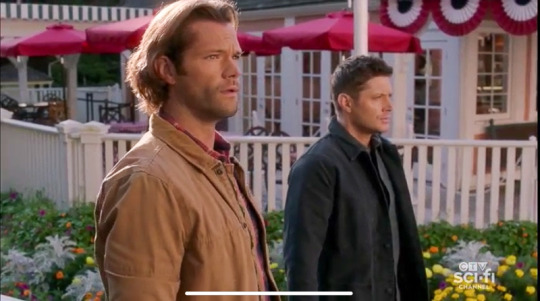
No one is crying. There is no reason for ANYONE to cry.
Sam sits on a bench and watches happy pie eating families (sob). Dean returns with a giant box with six slices of pie (16 points). He sits next to Sam, and they have this conversation:
What's wrong?
Nothing. I'm fine.
Nah, come on, I know that face. That's Sad!Sam face.
I'm not Sad!Sam. I just. I'm thinking about Cas, you know? Jack. If they could be here.
Yeah, I know, I think about them too. You know what, that pain's not gonna go away, right? But if we don't keep living, then all that sacrifice is going to be for nothing.
Dean's right, Sam. Do not be sad. We will have no Sad!Sam tonight. Live your life, or else those sacrifices are wasted. (ahem.) Sam responds by pushing a slice of pumpkin pie into Dean's face. "I've wanted to do that for a very long time," he laughs. "You're right, I do feel better!" Dean scraping the pie off his face and eating it is pretty adorable.
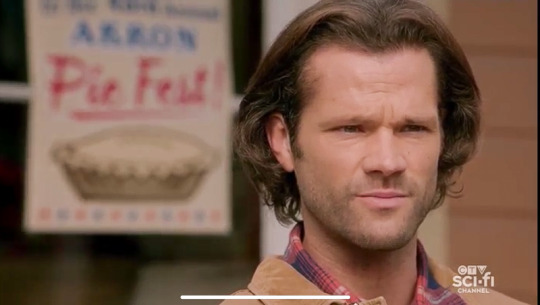
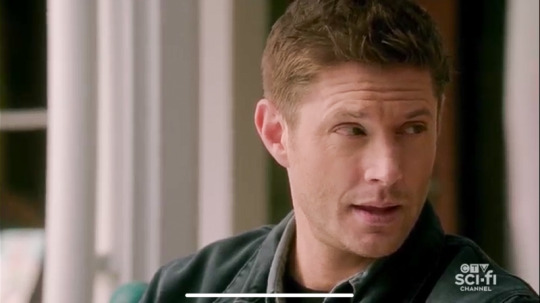
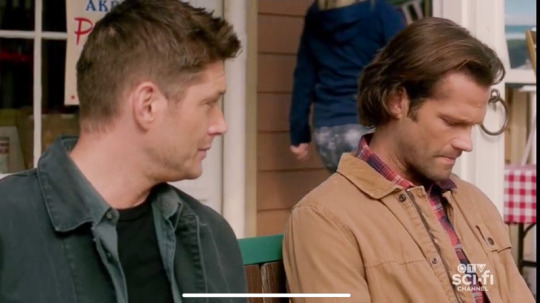
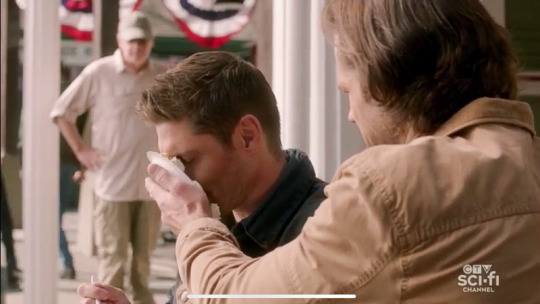
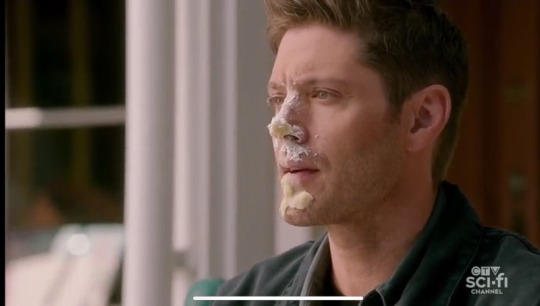

I'd pay good money to lick that off his face. And not just because I love pumpkin pie.
Not quite 6 minutes in and we're up to at least 16 guaranteed bits of pure fan service. Just sweet, domestic Winchester brothers living their lives. How long has this been going on? I've decided it's been at least a year since the last episode. Maybe longer. A good long time. Lots of time for them to enjoy their newfound freedom. But right now things are getting dark. Because it's nighttime, and because I think somebody's about to die.
A mom sends two young brothers upstairs for bathtime. They pause when the doorbell rings. No one seems to be there, but then the dad is stabbed by people wearing creepy masks. The boys run into their room and hide. From their room, we hear the mom scream, and then a thump. One of the masked guys comes into the room and, after a fake-out when we think they might be safe, drags the boys out from under the bed.
So, domestic life in the bunker and then a hunt? Wow. We're getting it all. What a great episode, full of the things we love.
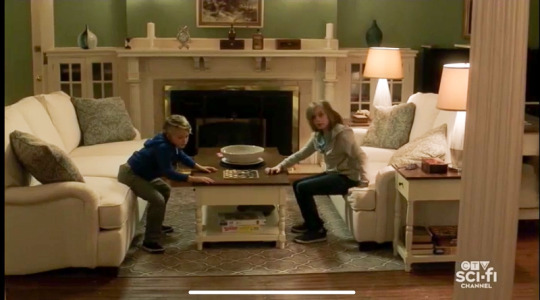
Is this Becky Rosen's living room?
Daytime. Agents Kripke and Singer (ugh, really? Kripke is good, but how about honoring someone other than the current regime?) show up at the scene. They learn that the dad's blood was drained, the mom is alive but her tongue was ripped out (wow), and the kids were taken. The mom drew a picture of the masks they wore, which the brothers recognize.
In a lovely, picturesque spot, the guys flip through John's journal. And I didn't realize we hadn't seen the journal in a while, but Tumblr informs me many of us were exicted to see it again, so boom. 17 points.
You know what this is? Mimes. Evil mimes.
Yeah. Or vampires.
VampMIMES. Son of a bitch!
Dean comes up with a silly portmanteau name for a monster? That will be 18 points. Sam determines the vamps will be heading for Canton if they follow their pattern, and the victims are families who live on the outskirts of town with children between the ages of five and ten. Well, that couldn't be too difficult to narrow down in a city with a population of over 70,000.
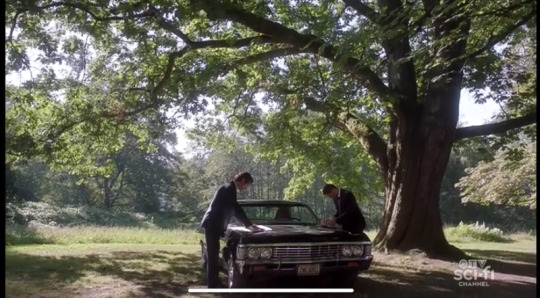
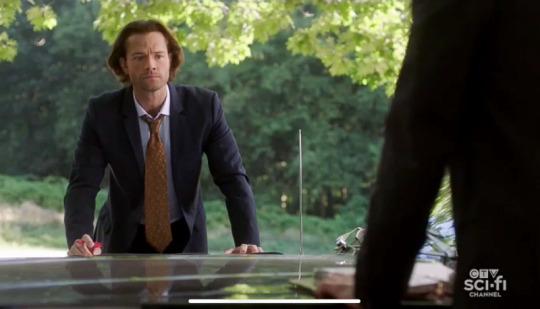
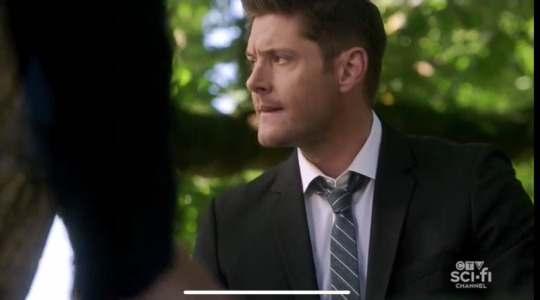
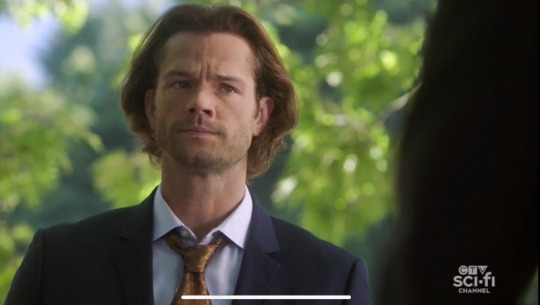
I'll handwave it. The lip biting. You’re welcome.
Night. Canton, I presume. Two masked vamps get out of a van. One of them gets decapitated by Dean. The other is shot in the leg, and then the head, by Sam. Well, he's a vampire, so of course it didn't kill him, but the bullet was soaked in dead man's blood. {Sidebar: "Soaked?" Dipped, maybe, but do you soak metal? Discuss.} They ask where the missing kids are, and the vamp is all, you're gonna let me go if I tell you? "No," Dean explains, adorably disappointed that the vamp isn't a mime after all. "This isn't a you walk out of here kind of situation. But see, if you tell us quick, you get this." He displays his bloody machete. "But if you take your time, you get, you get that." And "that" is a switchblade which Sam casually pops open right on cue.
Yeah, I'll take that. I'll take that itty bitty one.
It's a bad choice.
You see, this, this is quick. It's clean, you know? No muss, no fuss. You blink and you're dead.
But a blade this small, I'm gonna have to keep sawing and sawing to get your head off. And you'll feel it. Every muscle, tendon. Every inch. Could take hours.
Oh, and if those kids are dead? He's gonna use a spoon.
GUYS. I said it before and I’ll say it again. I absolutely love when they remind us that Sam Winchester, that sweet boy with the huge heart and the endless supply of empathy and the puppy dog eyes, I love it when they remind us that he is a fucking psycho when he needs to be. I'm not going to give it a point, because I don't think it's anything we've asked for, but again I'm willing to hear all arguments. Especially if they come with detailed examples of Sam going psycho. Just for evidence, you know.
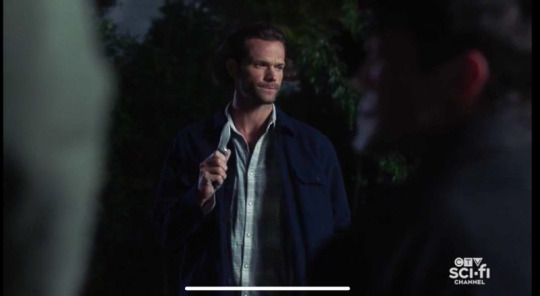


Just casually talkin' bout torturing you to death. No big.
The vampire wisely decides to reveal the location of the nest where the kids are being held. Next we see the Impala pulling up in front of some kind of barn. The guys open the trunk to get their gear out, and Dean pulls out a throwing star. "Come on. One time." Sam says no. There will be plenty of other times for Dean to use his throwing stars, I'm sure.
The guys enter the barn and find it apparently empty, although we see masked vamps peeking at them from outside. They find the kids locked in a closet, but four vampires appear before they can escape. They shoo the boys outside and shoot the vampires with their dead man's blood bullets from a safe distance. No, they don't. Why? I got no goddamn idea.
{Sidebar: At some point during this fight, I realized they hadn't played "Carry On Wayward Son" at the beginning. And that we got a regular montage, not a season finale extended montage.}
Sam gets knocked unconscious, and Dean loses his machete and then gets pinned by a couple of vamps. But they don't kill him; they just hold him down while an unmasked vampire strolls in. Dean recognizes her from season 1, and pretends not to notice Sam's now-conscious hand surreptitiously creeping toward his machete. Suddenly the vampire loses her head, because Sam is behind her, and the fight starts up again. Dean gets thrown into a wall right next to a big metal spike, which we focus on oddly. And then he gets thrown onto the spike. Oops. Sam kills the last of the vamps and doesn't notice Dean's predicament. He's all, cool, fight's over, let's go get those kids out of here. "Sam," Dean says, "I don't think I'm going anywhere."
Dean tells Sam there's something stuck in his back and it "feels like it's right through me." He keeps touching his chest as if he expects to feel it poking through. Sam reaches around to touch his back and his hand comes back bloody, and if that gives you All Hell Breaks Loose feels, there's a good reason. Sam tries to pull Dean off the spike, but Dean stops him. "It feels like this thing's holding me together right now." Sam's starting to panic and so am I. He wants to go get the first aid kid and call for help, but Dean stops him. And y'all, I'm just gonna have to type the whole thing out.
Sam, Sam. Stay with me. Please, stay with me, please.
Okay. Yeah.
Okay. Okay. Uh. Right. All right, listen to me. Um. You get those boys and you get them someplace safe, all right?
Dean? WE are gonna get them somewhere safe.
No. You knew it was always gonna end like this for me. It was supposed to end like this, right? I mean, look at us. Saving people, hunting things, it's what we do.
Stop, Dean, just stop
It's okay. It's okay. it's good. It's good. We had one hell of a ride, man.
I will find away, okay? I will find another way.
No. No. No, no no no no. No bringing me back, okay? You know that always ends bad.
Dean, please.
I'm fading pretty quick, so, there's a few things I need you to hear. Come here. Let me look at you. There he is. I am so proud of you, Sam. You know that? I've always looked up to you. Remember when we were kids, you were so damn smart. You never took any of Dad's crap. I never knew how you did that. And you're stronger than me. You always have been. Hey, did I ever tell you, that night that I came for you when you were in school? You know, when dad hadn't come back from his hunting trip?
Uh, the woman in white.
The woman in white, that's right. I must have stood outside your door for hours, cause I didn't know what you would say. I thought you'd tell me to get lost, or get dead. And I didn't know what I would have done if I didn't have you. Cause I was so scared. I was scared. Cause when it all came down to it, it was always you and me. It's always been you and me.
Then don't leave me. Don't leave me. I can't do this alone.
Yes you can.
Well, I don't want to.
Hey. I'm not leaving you. I'm gonna be with you. Right here. Every day. Every day you're out there, and you're living, and you're fighting, cause you, you always keep fighting. You hear me? I'll be there, every step. I love you so much. My baby brother. Well, I did not think this would be the day. But it is, it is, and that's okay. I need you, I need you to promise me. I need you to tell me that it's okay. I need you to tell me it's okay. Look at me. I need. I need. I need you to tell me it's okay. Tell me it's okay.
Dean. It's okay. You can go now.
Bye, Sam.
NO, IT IS NOT OKAY. THIS IS THE OPPOSITE OF OKAY.
And of course I haven't described Sam's face as he understands what's happening, Dean's occasional spasms of pain, the handholding, the fucking FOREHEAD TOUCH, the tears, the way Dean's hand drops away, the way Sam's hands shake as he clutches his dead brother (hello, AHBL again).
Maybe we just need to watch it.

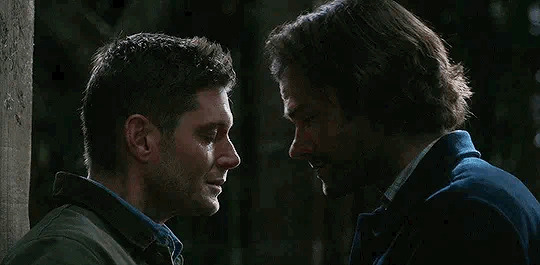

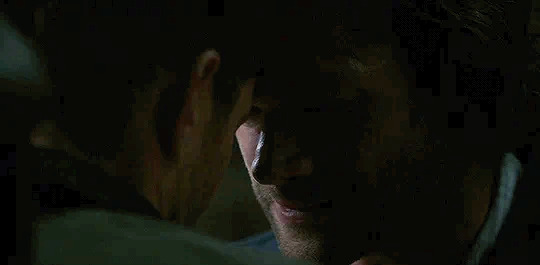

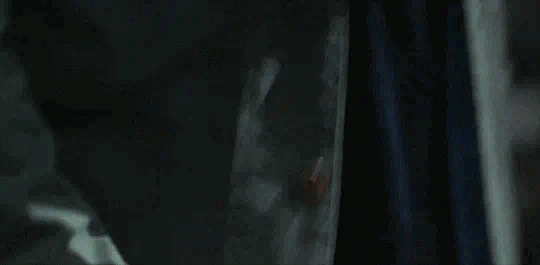
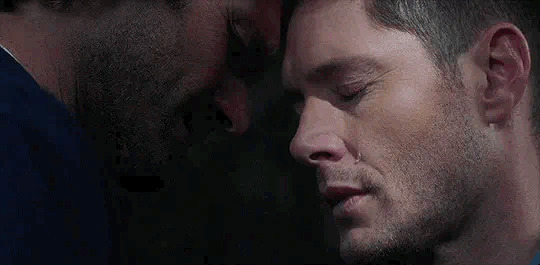
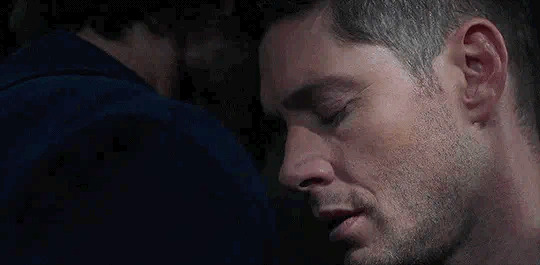
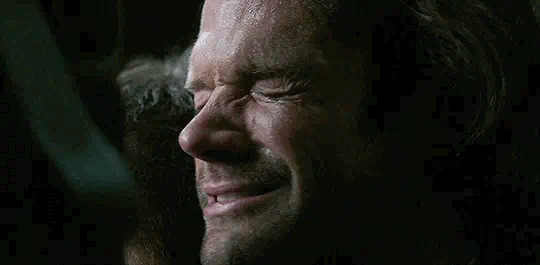
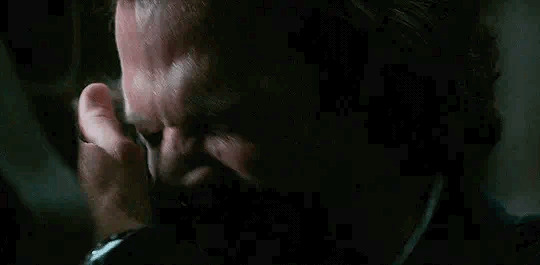
Gifs borrowed from @jaredandjensen.
And there's also the Always Keep Fighting shoutout, the "I love you," Dean calling Sam his "baby brother," the "I can't do this alone/Yes you can/Well I don't want to" parallel with 1.01. Infinite points, friends. I can't count that high.
(Things not to think about: Sam putting Dean's body in the back seat, and then putting the two young brothers in the front and driving them to safety. Sam driving 15 hours back to Lebanon with his brother's body. Do not think about these things.)
Aftermath. Sam and Miracle, and no one else, are giving Dean a hunter's funeral. And I know Covid means Sam couldn't have any friends there, but also? This is kind of perfect. Sam facing it alone. The song we hear as Sam lights his brother's pyre is "Brothers in Arms" by Dire Straits, in case you're not emotionally wrecked yet.
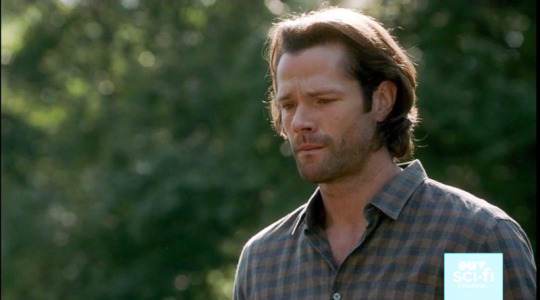
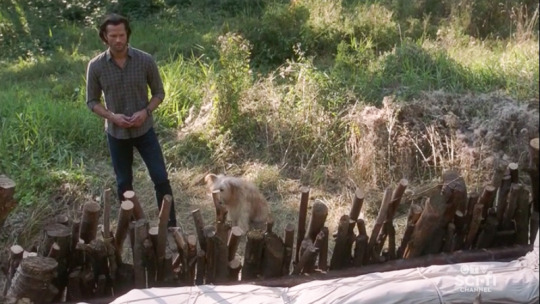
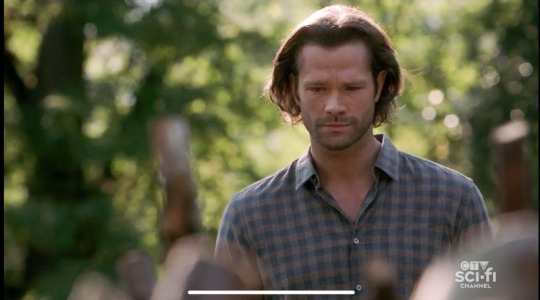
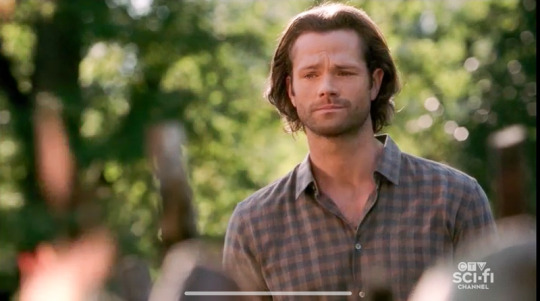
Yeah, I'm already there, thanks anyway.
Next we see Sam's slightly more modern alarm going off at 8:00. Note that Sam gets up later now, because at the beginning of the episode, he had already gone for a run and was cooking breakfast when Dean woke at 8:00. But now there's no one to cook for so he doesn't need to get back early and I AM NOT OKAY.
ANYWAY.
Sam gets up and faces his lonely day. He cooks eggs. One piece of toast pops up. He sits in the library with Miracle and looks at the names carved into the table. He wanders the halls with his dog at his side. (SAM HAVING A DOG WAS SUPPOSED TO MAKE HIM HAPPY. IT WAS SUPPOSED TO MAKE US HAPPY. HOW DARE YOU.)
{Sidebar: Has Sam ever had a dog when he wasn't at a low point in his already-low life? Discuss.}
Eventually he finds himself at the door to Dean's room. The room is just as Dean left it, kind of messy, kind of very full of Dean. He sits on Dean's bed and pets the dog and cries and it should come as a surprise to absolutely no one that I am ROLLING AROUND IN ALL OF THIS BEAUTIFUL PAIN.
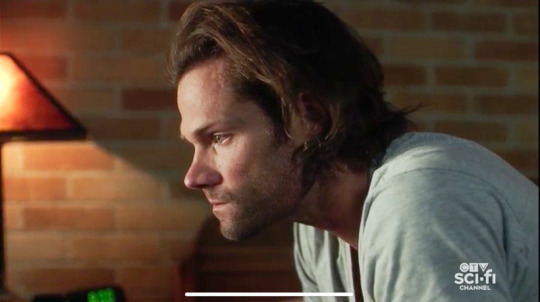
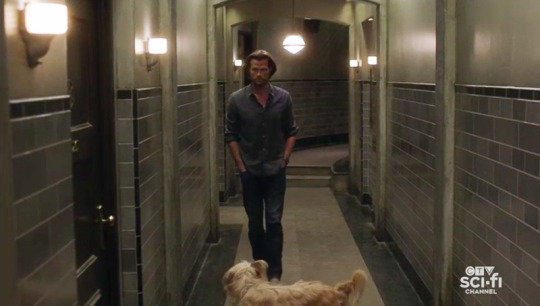
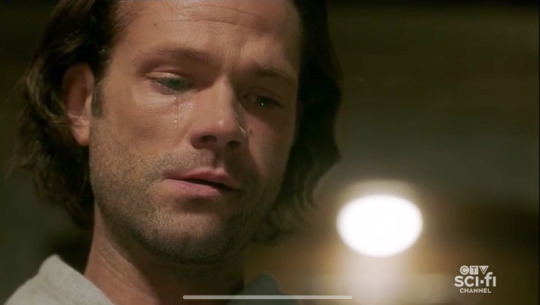
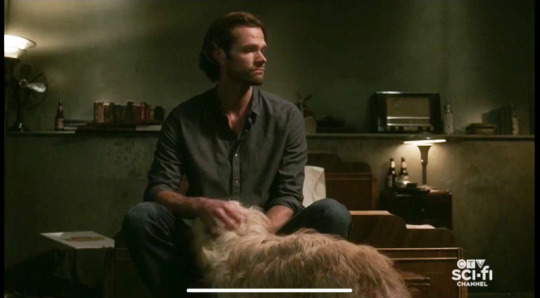

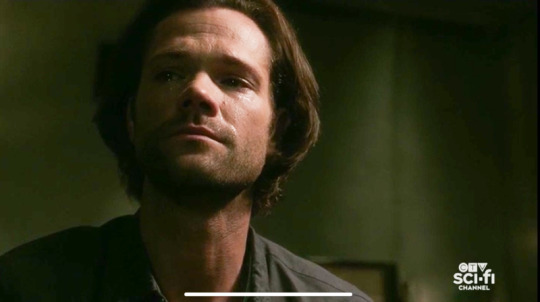

No one at all.
@annianvi thinks he’s wearing Dean’s hoodie when he cooks his sad lonely breakfast? Could it be?
Sam hears a phone buzzing in Dean's desk. He digs out the one labeled "Dean's other other phone" and answers. The caller asks for "Agent Bon Jovi" and says he's had some bodies turn up without hearts in Austin. "A friend of mine, Donna Hanscum, said you were the one to call." Oooh, are we sending him to Austin? Is Walker, Texas Ranger just going to be another fake name and fake badge? Now that's how you do a spinoff!
{Sidebar: Does Donna know about Dean? Did Sam tell anyone yet? Is the trying to get him out of the bunker and keep him busy? If so, wouldn't she have given the guy Sam's number, not Dean's other other phone? But maybe it's someone she talked to weeks ago. Discuss.}
Sam tells the caller he is on his way, and we see him with a packed bag, heading out of the bunker with Miracle. He turns to look one last time and then turns off all the lights. We haven't seen the bunker this dark since the day they found it. I don't think he's ever coming back. Goodbye, bunker. I know some people hated you, but I was not one of them. {Sidebar: Did he give the bunker key to anyone? Surely he wouldn't want all those resources to go to waste!}
So, I guess the episode title refers to Sam having (choosing?) to carry on after he loses his brother. THIS IS FINE.
Now we're back at Dean's pyre, and this time we drift up with the smoke. We catch up with Dean, outdoors, in a lovely setting with trees and birds. "Well, at least I made it to Heaven," he says. "Yep," someone answers. It's Bobby! Real Bobby, not AU Bobby! Dean's actually standing next to a building - a cabin, maybe - and Bobby is sitting on the porch.
What memory is this?
It ain't, ya idjit.
Yeah it is. Cause the last I heard, you, you were in in Heaven's lockup.
Was. Now I'm not. That kid of yours, before he went wherever, made some changes here. Busted my ass out. And then he, well, set some things right. Tore down all the walls. Heaven ain't just reliving your golden oldies any more. It's what it always should have been. Everyone happy, everyone together. Rufus lives about five miles that way. With Aretha. Thought she'd have better taste. And your mom and dad, they got a place over yonder. It ain't just Heaven, Dean. It's the Heaven you deserve. And we been waiting for you.
So Jack did all that.
Well, Cas helped. It's a big new world out there. You'll see.
So, I guess Cas made it out of the Empty? Dean smiles at that, but doesn't suggest finding him or anything. I approve. Bobby pulls out a couple of beers (the green cooler made it into Heaven!!!) and they share some bad beer. Dean comments that Heaven is "almost perfect," and Bobby knows EXACTLY what's missing, because of course he does. "He'll be along. Time up here, it's different. You got everything you could ever want, or need, or dream. So I guess the question is, what are you gonna do now, Dean?" Well, Dean doesn't have everything he could ever want or need, but he does see one thing - Baby. With her Kansas plates! Friends, that's two things I requested before the end that I didn't think I would ever see: a forehead touch, and Baby wearing her original plates. Thank you, Jack.
Dean's face lights up. "I think I'll go for a drive." As he walks to his car, we see the cabin is actually Harvelle's Roadhouse, albeit smaller, I think. Dean settles into his car and says "Hey, Baby" and when he turns her on, "Carry On Wayward Son" begins to play.
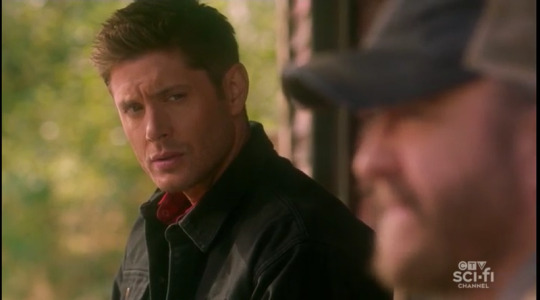
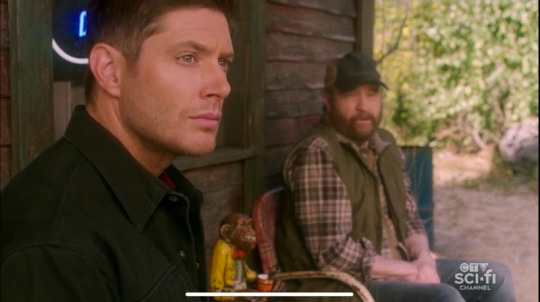
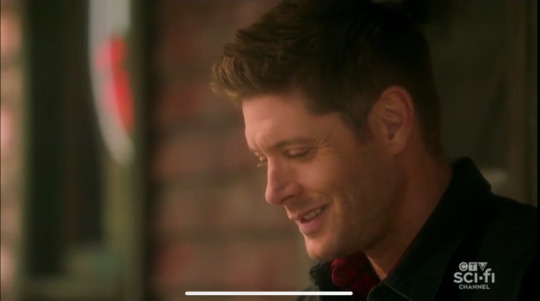


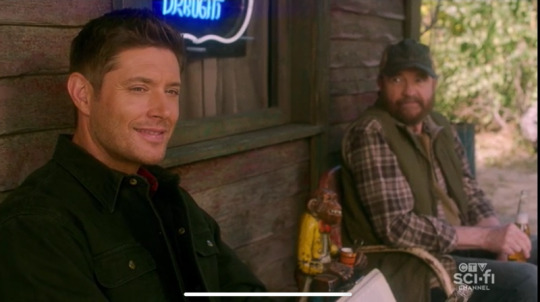
I know he looks good in Purgatory, but DAMN if he don't look fine in Heaven, too.
We cut to the name Dean, which is embroidered on - a little boy's overalls. Sam's little boy. Oh, wow. I was not prepared for this. Sam has a son named Dean, and we switch back and forth between Dean driving through Heaven and scenes of Sam's life with his son and his mysterious, barely-seen wife. She has long dark hair, and I'd like to point out that she could easily be either Eileen or Dr. Cara Roberts. Just saying. Sam's house is full of family photos, including the one of him and Dean from his memory box and a new one from the episode Lebanon. I never thought about the fact that they might have actually taken a photo, and if they did, would it still be around after Sam smashed the pearl? Well, obviously, yes. We see Sam throwing a ball with his son, helping him with his homework (Sam in glasses? Check!) and just obviously really loving this kid and giving him the childhood he never had. We also see a really, really unfortunate grey wig that I refuse to screencap. You're welcome. As aging Sam sits in the hundred-year-old car in his garage, his dead brother drives happily along dirt roads in Heaven, and I'd prefer my Heaven have paved roads, thanks.
We end in Sam's house, now complete with hospital bed. Sam could be in his 80s or even 90s, which means he could have lived another 50 years, more or less, after Dean died. His son doesn't look any older than his 20s or 30s (and also looks vaguely South Asian to me), and I wonder how old Sam was when he finally let himself have a family. Remember when Dean said his happy ending was for Sam to have kids and get old? Well, he got it, finally. Did Sam get a regular job? Did he keep hunting? We don't know. What we do know is that his son has a anti-possession tattoo. Some people have taken this to mean young Dean is a hunter, but I don't think we can jump to that conclusion. It could just be 1) Dean wanted a tattoo like his father's, or b) Sam knows there are still demons out there and that his son would naturally be a target, hunter or not.
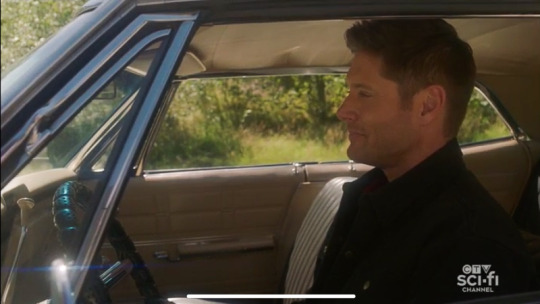

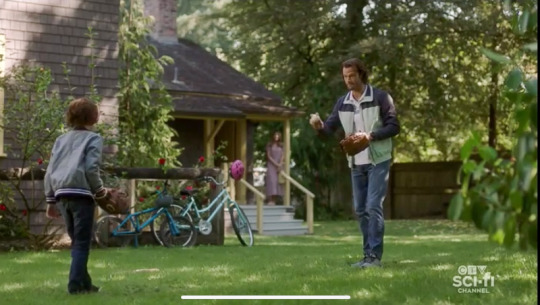

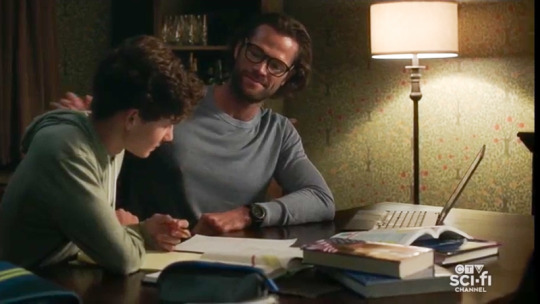
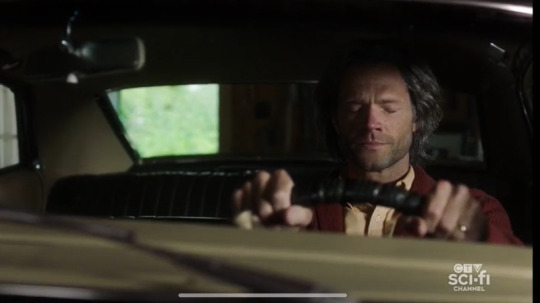
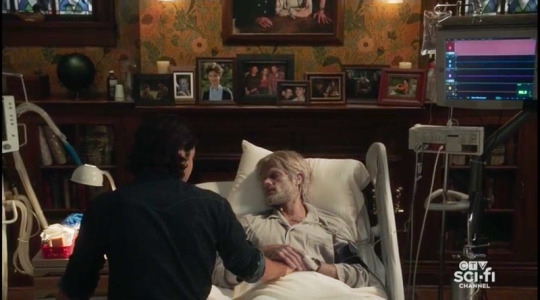
All right, I had to screencap teary-eyed Sam grasping the steering wheel and reliving his years with his brother in this car, so we can just pretend we don't see The Wig, okay?
Sam's evidently in hospice care. Or maybe we'll all have hospital beds in our houses in 50 years. Who knows. His son sits on the bed and takes his hand. Sam smiles at him, and Dean says "Dad, it's okay. You can go now." PARALLELLS! As some woman sings "Carry On Wayward Son" for whatever reason (why didn't they use the lovely a cappella version they already had from Fan Fiction?), Sam places his hand on Dean's and takes his last breath.
{Sidebar: Where is Sam's wife in all of this? Divorced? Already dead? She doesn't seem to be in the family pictures, so I'm going with divorced. Discuss.}
Heaven. Oh, guys. I've done this rewatch without tearing up at all but I'm about to tip over. The Impala pulls onto a bridge. Dean gets out. (Now your life's no longer empty, surely Heaven waits for you.) He stands at the bridge railing, enjoying Heaven, smiling. And then he feels something and he smiles even more because he knows it's Sam. Oh god, Jensen did such a good job here. Just this fucking smile killed me dead. "Hey, Sammy," he says. He turns and there is Sam, wearing the same outfit he wore in 1.01 (they both are, but Sam's is a bigger departure from his later years). Why? I don't know. But I know it means Sam Winchester is spending eternity in something that isn't a plaid shirt. How do we feel about that?
"Dean," Sam says. They face each other and smile, and it's the smile of we just survived a hunt I didn't think we'd survive or our son just overpowered God or something along those lines. Then they embrace, and I love the way Sam hesitates just a little before clapping a hand on Dean's back. Like he's afraid it isn't really happening, and he doesn't want to break the illusion. I also love that Dean, as always, takes the top (oh, get your minds out of the gutter) and hugs as if he were taller than Sam. Then Dean puts his hand on the back of Sam's neck and turns him to admire the view and he has this joyous smile like now, this is FINALLY Heaven. And he gazes at Sam like look, Sammy, look what we did. Look what we get. The lack of dialog in this scene is just ~chef's kiss~. The camera goes wide and we see the three main characters, Sam and Dean and Baby, enjoying the Heaven they deserve.



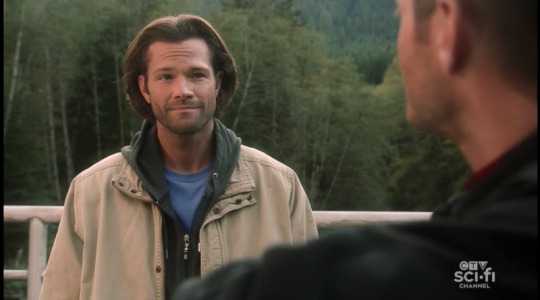


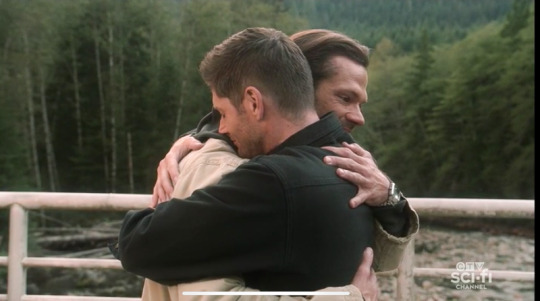



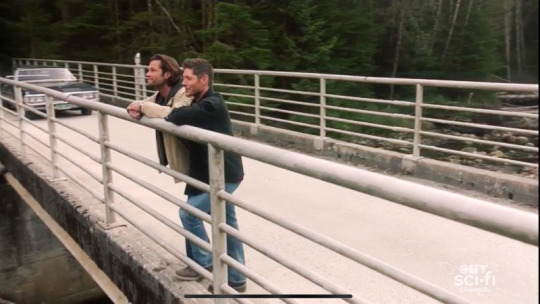

I would like to know where they filmed this, because it's gorgeous even without the Winchesters.
Did Sam's entire life go by in the span of Dean's drive? Or did Dean just decide he'd drive until his brother arrived, no matter how long it took? And how much do I love the fact that he could have gone and visited his parents but instead he said "nah, I'll drive around and wait for Sam?" SO MUCH, PEOPLE. SO MUCH.
Also, can we talk about the fact that Sam didn't know what to expect in Heaven? I mean, Ash said they were soulmates and would share a Heaven, but why would he believe that? And he might have even still believed he'd have a hard time getting into Heaven. What a relief it must have been to show up on Dean's bridge.
And then Jared and Jensen thank us. You're welcome, boys. Thank you.
So. Thursday night I was mildly positive about the episode. But on rewatch, I'm extremely positive. Sure, I would have loved the Six Feet Under ending where we see everyone's fate. And maybe that would have happened if not for Covid. But I'm just relieved we didn't get the Game of Thrones or How I Met Your Mother endings. I'm not sure this current cohort could have done better, honestly. Sam wanted a normal family life. Dean wanted Sam to have a normal family life. But Sam was never going to stop hunting as long as Dean was hunting. And Dean wasn't going to stop hunting as long as he was alive. Dean got the end he wanted/expected and the Heaven he earned (and Sam caring for Jack was directly responsible for Heaven's improvements). Sam got to live a normal life and have a family. As I said earlier, I suspect his marriage didn't last. (Or maybe he and Eileen or Cara got married for insurance purposes, and happily co-parented little Dean, but knew they weren't each other's one true love.) But I actually prefer that. Dean loved Sam more than he loved anyone. Sam loved Dean the same way. I'm glad Sam got to have a child (who he loves as much as his brother, but in a different way), but I don't want Sam and Dean to share their Heaven with Sam's wife.
Now, would I have done Dean's death differently? Yes. I did appreciate that they had him upright, so the brothers were face to face, just like AHBL. But being impaled on a spike was just less dramatic that I would have liked. I would have preferred that Sam immediately see his brother was dying, instead of Dean having to explain it to him. Dean could have had his jugular torn, slowly bleeding out, and still been on his knees (held up by Sam, hell yes) making his deathbed speech. And then I wouldn't have thought "would an ambulance be here by now if you'd called them?" halfway through it.
{Sidebar: What if Sam had fed Dean some blood from one of the dead vamps. Wouldn't that have kept him undead long enough to get fixed up, and then they could have done the vampire cure? Discuss.}
I know some people are very unhappy about the finale. Honestly, from what I can tell, most of those people are hard-core Destiel shippers. And I guess they wanted, as they always do, for the Dean and Castiel relationship to be more important than the Dean and Sam relationship. Sorry, guys, that was never gonna happen. In the end, it came down to the epic love story of Sam and Dean, just as it should have.
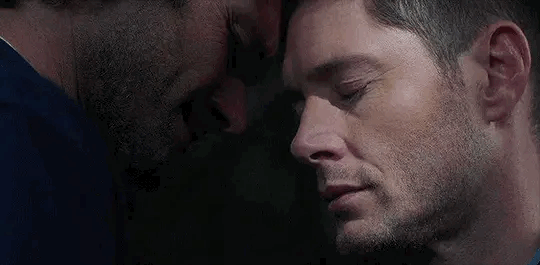
So, I'm sad and I'm happy. I'm bereft and I'm full. I miss my boys, but my boys will always be with me. I hope you guys will be with me for a long time, too.
81 notes
·
View notes
Text
Carter G. Woodson

Carter Godwin Woodson (December 19, 1875 – April 3, 1950) was an American historian, author, journalist, and the founder of the Association for the Study of African American Life and History. He was one of the first scholars to study the history of the African diaspora, including African-American history. A founder of The Journal of Negro History in 1916, Woodson has been called the "father of black history". In February 1926 he launched the celebration of "Negro History Week", the precursor of Black History Month.
Born in Virginia, the son of former slaves, Woodson had to put off schooling while he worked in the coal mines of West Virginia. He made it to Berea College, becoming a teacher and school administrator. He gained graduate degrees at the University of Chicago and in 1912 was the second African American, after W. E. B. Du Bois, to obtain a PhD degree from Harvard University. Most of Woodson's academic career was spent at Howard University, a historically black university in Washington, D.C., where he eventually served as the Dean of the College of Arts and Sciences.
Early life and education
Carter G. Woodson was born in New Canton, Virginia on December 19, 1875, the son of former slaves, Anne Eliza (Riddle) and James Henry Woodson. His parents were both illiterate and his father, who had helped the Union soldiers during the Civil War, supported the family as a carpenter and farmer. The Woodson family were extremely poor, but proud as both his parents told him that it was the happiest day of their lives when they became free. Woodson was often unable to regularly attend primary school so as to help out on the farm. Nonetheless, through self-instruction, he was able to master most school subjects.
At the age of seventeen, Woodson followed his brother to Huntington, where he hoped to attend the brand new secondary school for blacks, Douglass High School. However, Woodson, forced to work as a coal miner, was able to devote only minimal time each year to his schooling. In 1895, the twenty-year-old Woodson finally entered Douglass High School full-time, and received his diploma in 1897. From 1897 to 1900, Woodson taught at Winona. In 1900 he was selected as the principal of Douglass High School. He earned his Bachelor of Literature degree from Berea College in Kentucky in 1903 by taking classes part-time between 1901 and 1903. From 1903 to 1907, Woodson was a school supervisor in the Philippines.
Woodson later attended the University of Chicago, where he was awarded an A.B. and A.M. in 1908. He was a member of the first black professional fraternity Sigma Pi Phi and a member of Omega Psi Phi.He completed his PhD in history at Harvard University in 1912, where he was the second African American (after W. E. B. Du Bois) to earn a doctorate. His doctoral dissertation, The Disruption of Virginia, was based on research he did at the Library of Congress while teaching high school in Washington, D.C. After earning the doctoral degree, he continued teaching in public schools, as no university was willing to hire him, ultimately becoming the principal of the all-black Armstrong Manual Training School in Washington D.C. He later joined the faculty at Howard University as a professor, and served there as Dean of the College of Arts and Sciences. His dissertation advisor was Albert Bushnell Hart, who had also been the advisor for Du Bois, with Edward Channing and Charles Haskins also on the committee.
Woodson felt that the American Historical Association (AHA) had no interest in black history, noting that though he was a due-paying member of the AHA, he was not allowed to attend AHA conferences. Woodson became convinced he had no future in the white-dominated historical profession, and to work as a black historian would require creating an institutional structure that would make it possible for black scholars to study history. As Woodson lacked the funds to finance such a new institutional structure himself, he turned to philanthropist institutions such as the Carnegie Foundation, the Julius Rosenwald Foundation and the Rockefeller Foundation.
Career
Convinced that the role of his own people in American history and in the history of other cultures was being ignored or misrepresented among scholars, Woodson realized the need for research into the neglected past of African Americans. Along with William D. Hartgrove, George Cleveland Hall, Alexander L. Jackson, and James E. Stamps, he founded the Association for the Study of Negro Life and History on September 9, 1915, in Chicago. That was the year Woodson published The Education of the Negro Prior to 1861. His other books followed: A Century of Negro Migration (1918) and The History of the Negro Church (1927). His work The Negro in Our History has been reprinted in numerous editions and was revised by Charles H. Wesley after Woodson's death in 1950. Woodson described the purpose of the ASNLH as the "scientific study" of the "neglected aspects of Negro life and history" by training a new generation of blacks in historical research and methodology. Believing that history belonged to everybody, not just the historians, Woodson sought to engage black civic leaders, high school teachers, clergymen, women's groups and fraternal associations in his project to improve the understanding of Afro-American history.
In January 1916, Woodson began publication of the scholarly Journal of Negro History. It has never missed an issue, despite the Great Depression, loss of support from foundations, and two World Wars. In 2002, it was renamed the Journal of African American History and continues to be published by the Association for the Study of African American Life and History (ASALH).
Woodson stayed at the Wabash Avenue YMCA during visits to Chicago. His experiences at the Y and in the surrounding Bronzeville neighborhood inspired him to create the Association for the Study of Negro Life and History in 1915. The Association for the Study of Negro Life and History (now the Association for the Study of African American Life and History) ran conferences, published The Journal of Negro History, and "particularly targeted those responsible for the education of black children". Another inspiration was John Wesley Cromwell's 1914 book, The Negro in American History: Men and Women Eminent in the Evolution of the American of African Descent.
Woodson believed that education and increasing social and professional contacts among blacks and whites could reduce racism and he promoted the organized study of African-American history partly for that purpose. He would later promote the first Negro History Week in Washington, D.C., in 1926, forerunner of Black History Month.The Bronzeville neighborhood declined during the late 1960s and 1970s like many other inner-city neighborhoods across the country, and the Wabash Avenue YMCA was forced to close during the 1970s, until being restored in 1992 by The Renaissance Collaborative.
He served as Academic Dean of the West Virginia Collegiate Institute, now West Virginia State University, from 1920 to 1922. By 1922, Woodson's experience of academic politics and intrigue had left him so disenchanted with university life that he vowed never to work in academia again.
He studied many aspects of African-American history. For instance, in 1924, he published the first survey of free black slaveowners in the United States in 1830.
NAACP
Woodson became affiliated with the Washington, D.C. branch of the NAACP, and its chairman Archibald Grimké. On January 28, 1915, Woodson wrote a letter to Grimké expressing his dissatisfaction with activities and making two proposals:
That the branch secure an office for a center to which persons may report whatever concerns the black race may have, and from which the Association may extend its operations into every part of the city; and
That a canvasser be appointed to enlist members and obtain subscriptions for The Crisis, the NAACP magazine edited by W. E. B. Du Bois.
Du Bois added the proposal to divert "patronage from business establishments which do not treat races alike," that is, boycott businesses. Woodson wrote that he would cooperate as one of the twenty-five effective canvassers, adding that he would pay the office rent for one month. Grimké did not welcome Woodson's ideas.
Responding to Grimké's comments about his proposals, on March 18, 1915, Woodson wrote:
I am not afraid of being sued by white businessmen. In fact, I should welcome such a law suit. It would do the cause much good. Let us banish fear. We have been in this mental state for three centuries. I am a radical. I am ready to act, if I can find brave men to help me.
His difference of opinion with Grimké, who wanted a more conservative course, contributed to Woodson's ending his affiliation with the NAACP.
Black History Month
Woodson devoted the rest of his life to historical research. He worked to preserve the history of African Americans and accumulated a collection of thousands of artifacts and publications. He noted that African-American contributions "were overlooked, ignored, and even suppressed by the writers of history textbooks and the teachers who use them." Race prejudice, he concluded, "is merely the logical result of tradition, the inevitable outcome of thorough instruction to the effect that the Negro has never contributed anything to the progress of mankind."
The summer of 1919 was the "Red Summer", a time of intense racial violence that saw about 1,000 people, most of whom were black, killed between May and September 1919. In the face of widespread disillusionment felt in black America caused by the "Red Summer", Carter worked hard to improve the understanding of black history, later writing "I have made every sacrifice for this movement. I have spent all my time doing this one thing and trying to do it efficiently". The 1920s were a time of rising black self-consciousness expressed variously in movements such as the Harlem Renaissance and the Universal Negro Improvement Association led by an extremely charismatic Jamaican immigrant Marcus Garvey. In this atmosphere, Woodson was considered by other black Americans to be one of their most important community leaders who discovered their "lost history". Woodson's project for the "New Negro History" had a dual purpose of giving black Americans a history to be proud of and to ensure that the overlooked role of blacks in American history was acknowledged by white historians. Woodson wrote that he wanted a history that would ensure that "the world see the Negro as a participant rather than as a lay figure in history".
Woodson wrote "while the Association welcomes the cooperation of white scholars in certain projects...it proceeds also on the basis that its important objectives can be attained through Negro investigators who are in a position to develop certain aspects of the life and history of the race which cannot otherwise be treated. In the final analysis, this work must be done by Negroes...The point here is rather that Negroes have the advantage of being able to think black". Woodson's claim that only black historians could really understand black history anticipated the fierce debates that rocked the American historical profession in the 1960s-1970s when a younger generation of black historians claimed that only blacks were qualified to write about black history. Despite these claims, the need for money ensured that Woodson had several white philanthropists such as Julius Rosenwald, George Foster Peabody, and James H. Dillard elected to the board of the Association for the Study of Negro Life and History. Woodson preferred whites such as Rosenwald who were willing to finance his Association, but did not want to be involved in its work. Some of the whites that Woodson recruited such as the historian Albert Bushnell Hart and the teacher Thomas Jesse Jones were not content to play the passive role that he wanted, leading to personality clashes as both Hart and Jones wanted to write about black history. In 1920, both Jones and Hart resigned from the Board in protest against Woodson.
In 1926, Woodson pioneered the celebration of "Negro History Week", designated for the second week in February, to coincide with marking the birthdays of Abraham Lincoln and Frederick Douglass. The Black United Students and Black educators at Kent State University expanded this idea to include an entire month beginning on February 1, 1970. Beginning in 1976 every US president has designated February as Black History Month.
Colleagues
Woodson believed in self-reliance and racial respect, values he shared with Marcus Garvey, a Jamaican activist who worked in New York. Woodson became a regular columnist for Garvey's weekly Negro World.
Woodson's political activism placed him at the center of a circle of many black intellectuals and activists from the 1920s to the 1940s. He corresponded with W. E. B. Du Bois, John E. Bruce, Arturo Alfonso Schomburg, Hubert H. Harrison, and T. Thomas Fortune, among others. Even with the extended duties of the Association, Woodson was able to write academic works such as The History of the Negro Church (1922), The Mis-Education of the Negro (1933), and others which continue to have wide readership.
Woodson did not shy away from controversial subjects, and used the pages of Black World to contribute to debates. One issue related to West Indian/African-American relations. He summarized that "the West Indian Negro is free", and observed that West Indian societies had been more successful at properly dedicating the necessary amounts of time and resources needed to educate and genuinely emancipate people. Woodson approved of efforts by West Indians to include materials related to Black history and culture into their school curricula.
Woodson was ostracized by some of his contemporaries because of his insistence on defining a category of history related to ethnic culture and race. At the time, these educators felt that it was wrong to teach or understand African-American history as separate from more general American history. According to these educators, "Negroes" were simply Americans, darker skinned, but with no history apart from that of any other. Thus Woodson's efforts to get Black culture and history into the curricula of institutions, even historically Black colleges, were often unsuccessful.
Death and legacy
Woodson died suddenly from a heart attack in the office within his home in the Shaw, Washington, D.C. neighborhood on April 3, 1950, at the age of 74. He is buried at Lincoln Memorial Cemetery in Suitland, Maryland.
The time that schools have set aside each year to focus on African-American history is Woodson's most visible legacy. His determination to further the recognition of the Negro in American and world history, however, inspired countless other scholars. Woodson remained focused on his work throughout his life. Many see him as a man of vision and understanding. Although Woodson was among the ranks of the educated few, he did not feel particularly sentimental about elite educational institutions. The Association and journal that he started are still operating, and both have earned intellectual respect.
Woodson's other far-reaching activities included the founding in 1920 of the Associated Publishers in Washington, D.C. This enabled publication of books concerning blacks that might not have been supported in the rest of the market. He founded Negro History Week in 1926 (now known as Black History Month). He created the Negro History Bulletin, developed for teachers in elementary and high school grades, and published continuously since 1937. Woodson also influenced the Association's direction and subsidizing of research in African-American history. He wrote numerous articles, monographs and books on Blacks. The Negro in Our History reached its 11th edition in 1966, when it had sold more than 90,000 copies.
Dorothy Porter Wesley recalled: "Woodson would wrap up his publications, take them to the post office and have dinner at the YMCA. He would teasingly decline her dinner invitations saying, 'No, you are trying to marry me off. I am married to my work'". Woodson's most cherished ambition, a six-volume Encyclopedia Africana, was incomplete at the time of his death.
Honors and tributes
In 1926, Woodson received the National Association for the Advancement of Colored People Spingarn Medal.
The Carter G. Woodson Book Award was established in 1974 "for the most distinguished social science books appropriate for young readers that depict ethnicity in the United States."
The U.S. Postal Service issued a 20-cent stamp honoring Woodson in 1984.
In 1992, the Library of Congress held an exhibition entitled Moving Back Barriers: The Legacy of Carter G. Woodson. Woodson had donated his collection of 5,000 items from the 18th, 19th, and 20th centuries to the Library.
His Washington, D.C. home has been preserved and designated the Carter G. Woodson Home National Historic Site.
In 2002, scholar Molefi Kete Asante named Carter G. Woodson on his list of 100 Greatest African Americans.
On February 1, 2018, he was honored with a Google Doodle.
40 notes
·
View notes
Photo

Some CFL teen program dates flyin’ atcha!
#teen library programs#Canton Free Library#CFL#North Country Library System#NCLS#Anime Club#Let's Play#Casuals Wielding Dice
1 note
·
View note
Text
Inking and teaching

Hey, Yaw’ll,
I’m in intense inking mode for my graphic novel, Timid. That means I’m trying to graphically solidify—in India ink—all of the adventures of my protagonist, 12-year-old Cecil Hall, in the more than 250 pages of his story about growing up on the East Coast in the1980s. If you’re curious about my work, I’m participating in a reading in the hip city of Somerville, Massachusetts, on Sunday, November 17, at 3 p.m. at the Arts at the Armory Café, 190 Highland Ave. The Writers Helping Writers Reading & Raffle is a benefit to raise scholarship money for writers striving to earn Master of Fine Arts degrees. I’m including a copy of the flyer in this blog post.
And the other big news is that my friends and I are planning the next Boston Kids Comics Fest, which is scheduled for Saturday, April 25, 2020. Check out the website for blossoming details, and if you’re a cartoonist who draws work for kids, please consider exhibiting! It’ll be at a huge Salvation Army community center in Boston that looks like a resort; the Kroc Center was financed by a bequest of Joan Kroc, the wife of McDonald’s founder Ray Kroc. The Boston Kids Comics Fest strives to raise awareness about graphic novels and comics that are designed for kids, in addition to encouraging children to write, draw, and sell their own comics. Please support both the Boston Kids Comics Fest and the Writers Helping Writers fund!
Okay, so in addition to inking, here’s what else I’m up to reading and teaching-wise for the next few months:
November 11/12 - Teaching children’s workshop on drawing graphic novel pages at the Morse Institute Library at 14 E. Central Street in Natick, MA
11/17- Writers Helping Writers Reading & Raffle at the Arts at the Armory Café, 190 Highland Ave. Somerville, MA, on Sunday from 3 to 5 p.m.
December 12/30 - Teaching children’s workshop on drawing graphic novel pages at the Wellesley Free Library, 530 Washington St. Wellesley, MA
February 2/18 - Teaching children and teen workshop on drawing autobiographical comics at the Mattapan Branch of the Boston Public Library, 1350 Blue Hill Avenue, Mattapan, MA
2/20 - Teaching children’s workshop on drawing comic-book pages at the Milton Public Library, 476 Canton Ave, Milton, MA
March 3/12- Teaching children’s workshop on drawing autobiographical comics at the Southborough Public Library, 25 Main St, Southborough, MA
3 notes
·
View notes
Text
Regan and Teegan - Pt 1
Regan Kelly joined Cerberus to escape Colony life - Teegan came to Omega to avoid being conscripted into a Cabal.
Neither expected to be thrown together in the midst of a shit-show, forced to work together to keep from being killed by the Adjutants left roaming the station.
Neither expected to get attached, either.
Fits into my Kissing Turians AU Universe.
She’s born blind.
Half blind, actually - though her right eye’s such a pale grey the doctors had initially assumed it was full blindness.
She’d reacted to things on that side, though - was otherwise a happy, healthy baby, if quieter than most, and her parents took to raising her as such.
Kids are cruel, though, no matter their location - New Canton was no stranger to bullying, and at school her difference was treated almost as a disease - something to make fun of from afar.
Regan ignored them, at first. She had more important things to think about then childish bullies - the small library of their colonies school just begged for her attention, and she happily spent her free time tucked in a corner, devouring sagas meant for youths much older then her.
A genius. Her teachers said, showering praise during conferences with her parents, Reading at far-above her age level. But a loner. Unsociable.
She’ll grow out of it. Her parents said, but she never did - preferring her books to people, eventually beginning to tinker and create drones with spare parts scavenged from around the colony, knowing she was meant for more then the colony life her parents enjoyed.
Discovering her biotics was a fluke - and the only reason the bully who’d triggered them was still alive was her damn terrible depth perception.
Not that the teachers believed she’d attacked them on purpose. Regan? Leave the poor girl alone, Joseph - as if she could crack a window with her mind, please.
She trained by herself, tucked away in her bedroom while her parents were at work or asleep, learning to control these new abilities, furthering her skills with tech.
Regan applied to the Alliance as soon as she turned 18, wanting to be off the colony and making a name for herself, not stuck being a poor colonist for the rest of her life like her parents.
Her application was denied, and she scowled and let her biotics flare in anger at their reasoning, teeth bared at the computer screen.
Applicant Denied due to unfavorable disability - partial blindness on the field would be a hindrance.
Are you kidding me?! I didn’t apply to be on the field! Did they even read the rest of my application??
She’d attached every commendation and recommendation she’d ever gotten from her teachers - about her prowess with tech, her quick thinking skills and ease at picking up new programs and languages - all for naught, it seemed.
God fucking dammit! I just want off of this rock!
Maybe a year later, after yet another declined application to the Alliance, she hears about Cerberus.
They don’t have the best reputation, but they have open positions in tech, and offer good money - she wouldn’t be on the front lines, and it’d get her off of the Colony. She sends in an application without much thought, half-expecting the same response as the Alliance.
Imagine her surprise at the almost immediate email declaring she’s been accepted, and to be ready for pick-up at a date TBA.
Regan is twenty when she leaves New Canton to join Cerberus, welcomed aboard her shuttle by a smiling woman and several soldiers in white, black, and yellow, and she doesn’t look back.
#mass effect#mass effect fanfiction#mass effect ocs#regan kelly#cerberus#biotic#prologue#kissing turians au#blindness#disability: vision impaired#mass effect oc#turian/human relationship#eventually
5 notes
·
View notes
Text
Day 2, 22nd August, Zurich.
Switzerland has a population of 8 million people with Berne being the Capital. Zurich is the largest city with 1.5 million. Switzerland is one of the most developed countries in the world and Zurich is ranked second globally in regard to quality of life.
I started the day at 3.30 in the morning. I couldn’t sleep but felt fine. There is an 8 hour time difference between here and home. I enjoyed a leisurely breakfast and then caught the train into the city. The hotel was about 2 minutes from a train station so in 15 minutes I was in the city and had dropped my bags at the hotel ready for the day.

Up first I was on a mission to find the University which was on the other side of the river.

It was pretty early so the shops weren’t open and not that many people around.

Legend goes that when the city was surrounded by walls the moat was full of frogs which were very noisy and alerted those inside the walls of any attackers. Consequently, you see frogs on many buildings and statues around the city.

In particular, at the University I was looking for the Law Library. I had heard a guy on the radio talking about libraries around the world, a few months ago, and the Zurich Law Library being one of his favourites. I’ve seen some interesting and impressive libraries in my travels so wanted to find this one. Also it’s designed by a Spanish architect, Santiago Calatrava, who was an ex student of the Uni. I have seen his buildings in Valencia, Lisbon and in Toronto. He has designed some amazing structures.

Back down the hill through some of the old town. It was much cooler than I expected and overcast. I was hoping it wasn’t going to rain.

Lots of colourful nooks and crannies through the streets.

Very cheerful shop.

Interesting little window boxes overlooking the street. A lot of houses had plaques on them indicating their age and who used to live in them. Some went back to the 14 th Century.

This church tower has the largest tower clock in all of Europe including Big Ben in London. Switzerland being known for clocks.

The churches are all very plain as they are Protestant churches. Switzerland became a Protestant country after the Reformation over 500 years ago. All the Catholic Churches became Protestant ones.

Lovely colourful streets

I joined a “free” walking tour which I always enjoy. Around Zurich there are 1200 drinking fountains. This one is a new design and once a year the water turns to wine in this fountain. It becomes a popular place to hang out on that day.

Nice square with tables. Lots of outdoor eating areas all over..

This building used to be an Abbey built in 853 for aristocratic women. The Frau Munster.

Many nuns lived here and their story was painted on the walls.

It was a beautiful building. It now belongs to the reformed church of Zurich.

The highest point in Zurich is on Lindenhof. There was once a Roman settlement up here. There were good views over the city.

The double towers are the Grossmunster

Very picturesque.

The river was extremely clean and you could see the bottom. The current was running pretty fast.

Behind me is the last bridge before the lake.

You can see the wall of Lindenhof where my photo was taken

There are always interesting things to see around the city. Dairy products are important to Switzerland so cows are prominent. This one was called Heidi and has been up there a long time.

Narrow streets. The old town is on both sides of the river.

This clothing shop used to be a burlesque theatre. The decorations remain.

In this building Lenin was supposed to have resided. Also, it is thought he still has a Switzerland bank account but no one will ever know now.

Another lovely fountain. You do see people drinking from the fountains or filling up their water bottles. All very clean.

This is the Grossmunster. The towers were never completed so when they were the style chosen wasvery different from the original building. Locals call the towers pepper and salt shakers.

I didn’t expect to see this sight in Zurich. Not sure who they were or what they were doing.

The Bahnstrasse which is considered the most expensive shopping street in the world. The city has a great transport system and trams are frequent.

The flags you see are either the Swiss flag or flags of one of the 26 Cantons (states) in the country.

I was staying in a great spot so checked in a bit early after the tour and before heading to the National Museum.

There were a lot of great exhibitions about Switzerland and Zurich’s history. I was interested in the information about how Switzerland became a Neutral country, the huge 3D map of the country and fascinated with the exhibition of Heidi goes to Japan.

I didn’t know any of this but in 1973 four Japanese young men visited Switzerland looking for material for their next project, a series of cartoons, known in Japan as ‘anime’. They wanted to base it on Johanna Spyn’s Heidi novels.

Now the world famous story of Heidi owes its popularity not only to the original children’s books but as a consequence of the Japanese cartoon series becoming so popular internationally. This has had a marked impact on the image of Switzerland and Swiss culture all over the world. I’m showing my age, here, as I only remember the story of Heidi from a Golden Circle book I owned as a child in the 50′s.

This is the Zurich’s main train station. Always impressive buildings in European cities. From here I thought I would change pace and catch a train to West Zurich which has some alternative structures and areas.

First thing I saw out of Hardbrucke station was a Salvos shop. I couldn’t miss this opportunity.

Lots of stuff but nothing that caught my eye.

This is the Freitag Flagship store and tower made out of containers. The brand is big on recycling.

Next door is an area called Frau Gerald’s Garten which is a lovely area of garden and cafes. It reminded me a bit of The Grounds at Alexandria.

Lots of interesting things and all recycled.

Lots of colour. Music is played at night and on weekends.

These umbrellas were in an alley further along. They always add some colour.

An old Viaduct now contains shops

The blue building is the Prime Tower which was the highest skyscraper in Switzerland from 2011 until 2015 when the Roche Tower in Basel was finished.

Back in the city you find many chocolate shops with brands you recognise.

After having a wander that was me just about done. My feet were giving out. I walked 21,000 steps today so no easing into my travels. Tomorrow will be more relaxed.

2 notes
·
View notes
Text
Raw Business secured page
Raw Business secured page
A early Saturday late day limited hours limited income with great business success
Enoch Pratt Free library Central Intelligence cathedral and mulberry family business, online alphabet military language and Pythagorean numerology anagram and palindrome Secured Planetary Media Communication's A social public and private communication, A perfectionist after-hours off line business to venture in , noted I am not A stranger to Communications Secured and business.
Weekend Business is Becoming more daily and more daily routine generation of revenue Blue Water Throne and other personal works , TH one Racing.... ?
A Vision as TH one Racing series becomes topic of Conscious though.
Pmug Abbub Business Security the Purple route to John's Hopkins Hawkins University arriving across the street from the Hotel , Sonelle ... Royal Sonesta Inner Harbor.
A quiet public transportation ride window clear view direction north from south .
I am Early for an Social Support Group meet but loving the scenery , Approaching Peabody mews and Washington Monument , the beautiful sight of Cherry blossom and spring season sense of day light savings..
Note life savings account and banking accounts Secured during day light savings.
Just added trust , The George Washington and in God we trust
Online share business and banking missions AND foundations
Trillion dollar brokering day at least potential.
In God we trust on every one of them .
But the Francis Key Scott in God our trust , with an hour !
Deep stuff !!!!
The All seeing eye ?
The Eye of Horus and Hours ..
Maybe Bank on the Eye of Oden Eden and A Garden.
Like it's life's salvation
Passagers exiting the bus approximately twelve mixture of culture and gender.
Entering town Haneunai Hills Haneunim Korea town from Shangdiying China Town.
Noted two male sex I myself included ..
I am so Getting my Captloven up , incline.
Passing the 25th street crossing North Charles street
The Church and Star maples in spring.. titles and Poetry
Like Searching for Paradise ,
Just Searching for Paradise and A pair of dice on one die to roll twice and loop or pool it's Canton.
Exiting the bus purple shuttle looking up , in white Letters Kajiken
1 note
·
View note
Text
East Michigan Warming Centers
JACKSON COUNTY
King’s Center Shelter Intake: Call to be screened and added to the intake waitlist, (517) 788-4067 . Hours: Intake screening: 8am-5pm Monday-Friday.
Kelly Warming Center 607 W Main Street, Medford OR 97501 Intake: Shelter is accessed through an application process for the winter season. Call 541-499-0880 or walk in to Rogue Retreat, 1410 8th Street, Medford to fill out an application. Hours: Application: Monday-Friday 8am-5pm. Shelter: January 1-March 30, 2019 7 days per week 7pm-8am Serves: Unrestricted. No pets.
MACOMB COUNTY
Bruce Township Bruce Township Government Office: 8:30 a.m. to 4:30 p.m. Monday through Friday at 223 East Gates; 586-752-4585. Center Line Center Line Parks & Recreation: 10 a.m. to 5 p.m. Monday through Thursday and noon to 5 p.m. Friday at 25355 Lawrence; 586-758-8267. South Eastern Michigan Indians: 9 a.m. to 4 p.m. Monday through Friday at 26641 Lawrence; 586-756-1350. Chesterfield Township Chesterfield Township Library: 10 a.m. to 8 p.m. Monday through Thursday, 10 a.m. to 5 p.m. Friday and 10 a.m. to 4 p.m. Saturday at 50560 Patricia Avenue; 586-598-4900. Clinton Township Clinton-Macomb Main Library: 9 a.m. to 9 p.m. Monday through Thursday and 9 a.m. to 6 p.m. Friday and Saturday at 40900 Romeo Plank Road; 586-226-5000. Clinton-Macomb South Library: 9 a.m. to 9 p.m. Monday through Thursday and 9 a.m. to 6 p.m. Friday and Saturday at 35891 South Gratiot Avenue; 586-226-5070. Eastpointe Eastpointe Memorial Library:10 a.m. to 8 p.m. Monday through Thursday and noon to 5 p.m. Friday and Saturday at 15875 Oak; 586-445-5096. Harrison Township Harrison Township Government Office: 8 a.m. to 4:30 p.m. Monday through Friday at 38151 L’Anse Creuse; 586-466-1400. Macomb Township Clinton-Macomb North Library: 9 a.m. to 9 p.m. Monday through Thursday and 9 a.m. to 6 p.m. Friday and Saturday at 16800 24 Mile Road; 586-226-5082. Memphis Memphis Public Library: Noon to 8 p.m. Monday and Thursday, 9 a.m. to 5 p.m. Monday and Wednesday through Saturday at 34830 Potter; 810-392-2980. Memphis Fire Department: As necessary during extreme temperature events at 35095 Potter; 810-392-2385. Mount Clemens Macomb County Health Department: 8:30 a.m. to 5 p.m. Monday, Tuesday, Thursday and Friday, and 8:30 a.m. to 6:30 p.m. Wednesday at the Central Health Service Center at 43525 Elizabeth Road; 586-469-5235.
Macomb County Sheriff’s Department: 24 hours a day Monday through Sunday at 43565 Elizabeth Street; 586-469-5151.
Martha T. BerryMedical Care Facility: 9 a.m. to 6 p.m. Monday through Sunday at 43533 Elizabeth Road; 586-469-5265
Ray of Hope Day Center: 7 a.m. to 7 p.m. Monday through Friday at Two Crocker Blvd., Suite 201; 586-329-4046. Richmond Lois Wagner Memorial Library: 11 a.m. to 7 p.m. Monday through Wednesday, 9 a.m. to 5 p.m. Thursday and Friday and 10 a.m. to 2 p.m. Saturday at 35200 Division Road; 586-727-2665. Roseville MCREST: As the temperatures drop in the next two days, MCREST will be able to shelter 60 men, women and children at 20415 Erin in Roseville; 586-415-5101.
Recreation Authority Center: 8 a.m. to 6 p.m. Monday through Friday at 18185 Sycamore; 586-445-5480. St. Clair Shores Macomb County Southeast Family Resource Center: 8:30 a.m. to 6:30 p.m. Monday and 8:30 a.m. to 5 p.m. Tuesday through Friday at 25401 Harper Avenue; 586-466-6800. Shelby Township Shelby Township Senior Center: 8:30 a.m. to 5 p.m. Monday through Friday at 51670 Van Dyke; 586-739-7540. Utica Utica United Methodist Church: 8659 Canal, Sterling Heights; 586-731-7667. Warren Macomb County Health Department: 8:30 a.m. to 5 p.m. Monday through Wednesday and Friday, 8:30 a.m. to 6:30 p.m. Thursday at the Southwest Health Center at 27690 Van Dyke; 586-465-8090.
Max Thompson Family Resource Center: 8:30 a.m. to 5 p.m. Thursday at 11370 Hupp; 586-759-9150.
Salvation Army MATTS (Macomb’s Answer To Temporary Shelter): Call for overnight shelter availability and location — 24140 Mound Road; 586-755-5191. Washington Township Washington Township Government Office: 8 a.m. to 5 p.m. Monday through Friday at 57900 Van Dyke — a half-mile north of 26 Mile Road; 586-786-0010. OAKLAND COUNTY Auburn Hills Auburn Hills Community Center: 8 a.m. to 5 p.m. Monday, 8 a.m. to 9 p.m. Tuesday through Friday and 10 a.m. to 9 p.m. Saturday at 1827 N Squirrel Road; 248-370-9353. Farmington Hills Costick Center: 28600 W. Eleven Mile Road between Middlebelt and Inkster from 6 a.m. to 10 p.m. Monday through Friday and 7 a.m. to 9 p.m. Saturday and Sunday; 248-473-1800. Ferndale Gerry Kulick Community Center: 9:30 a.m. to 8 p.m. Monday through Thursday, 9:30 a.m. to 5 p.m. Friday and 9 a.m. to 4 p.m. Saturday and Sunday at 1201 Livernois Road. Lake Orion Orion Center: The building will reopen outside of regular business hours if large power outages exist in Orion Township community — 9 a.m. to 4:30 p.m. Tuesday, Wednesday and Friday, and 9 a.m. to 9 p.m. Thursday at 1335 Joslyn Road. Lathrup Village City of Lathrup Village City Hall: 6 a.m. to 4:30 p.m. at 27400 Southfield Road. Novi Meadowbrook Commons: 8 a.m. to 5 p.m. Monday through Friday at 25075 Meadowbrook Road. Novi Civic Center: 8 a.m. to 5 p.m. Monday through Friday at 45175 Ten Mile Road. The Novi Civic Center will be open Tuesday starting at 9 p.m. and remain open until 8 a.m. on Friday as a warming center for residents who need a warm place to rest. Residents will have access to clean restrooms, water, cell phone charging stations and free Wi-Fi.
Novi Public Library: 10 a.m. to 9 p.m. Monday through Thursday, 10 a.m. to 6 p.m. Friday and Saturday, and noon to 6 p.m. Sunday at 45255 W. Ten Mile Road. Oak Park Oak Park Community Center: 8 a.m. to 10 p.m. Monday through Thursday at 14300 Oak Park Boulevard. Royal Oak Genesis the Church: 309 N. Main Street, Royal Oak, from Jan. 27 through Feb. 10. Southfield Covenant Presbyterian Church: 21575 W. 10 Mile Rd in Southfield from 6:30 a.m. to 8 p.m. Monday through Friday; 248-289-0213. Troy Troy Community Center: 5 a.m. to 10:30 p.m. Monday through Thursday, 5 a.m. to 10 p.m. Friday, 7 a.m. to 8 p.m. Saturday and 8 a.m. to 6 p.m. Sunday at 3179 Livernois Road. Wixom City of Wixom City Hall/Police Department: As long as it is dangerously cold at 49045 Pontiac Trail.
WASHTENAW COUNTY Ann Arbor NOTE: Weekday daytime shelter accommodations are available at local congregations at varying times, generally from 9 a.m. to 4 p.m. Delonis Center: An overnight warming center for those experiencing homelessness. The shelter is available at 6:30 p.m. every night between Nov. 12, 2018, and April 1, 2019. There is also onsite dinner provided at 5 p.m. The address is 312 W. Huron Street in Ann Arbor.
First Baptist Church: From Feb. 1 through Feb. 28 on Tuesdays and Thursdays — 517 East Washington in Ann Arbor.
First Congregational: From Feb. 1 through Feb. 28 on Mondays, Wednesdays and Fridays — 608 East William in Ann Arbor.
St. Mary’s Student Parish: From Jan. 1 to Jan. 31 at 331 Thompson in Ann Arbor. WAYNE COUNTY Canton Township Canton Public Library: 1200 S. Canton Center Road — 734-397-0999 –9 a.m. to 9 p.m. Monday through Thursday, 9 a.m. to 6 p.m. Friday and Saturday, noon to 6 p.m. Sunday.
Summit on the Park: 46000 Summit Parkway — 734-394-5460 — 5:30 a.m. to 10 p.m. Monday through Friday, 6 a.m. to 8 p.m. Saturday, 7 a.m. to 8 p.m. Sunday. Detroit Cass Community Social Services: Located at 1534 Webb, 40 beds are available and services are provided for families (male and female parents and children). The center is open from 4 p.m. to 8 a.m. Contact the Cass Community Social Services at (313) 883-2277.
Detroit Rescue Mission Ministries: 100 beds for men only. The center, located at 3535 Third Avenue near downtown Detroit, is open from 6 p.m. to 9 a.m. For information, contact the Detroit Rescue Mission at (313) 993-6703. Detroit Rescue Mission Ministries: Second location has 25 beds for women and children only. The center, located at 3840 Fairview between Mack and St. Jean, is open from 4:30 p.m. to 9 a.m. For information on this location, contact the Detroit Rescue Mission at (313) 331-8990.
Detroit VA: The Detroit VA will provide a warming center for area veterans and their families in room B1290 of its facility at 4646 John R in Detroit from 9 a.m. to 4 p.m. Monday and Tuesday.
Eastern Market Team Wellness Center: The doors are opening to the community this week as a public warming center for those seeking shelter from the frigid temperatures. The Eastern Market location will be available from 8 a.m. to 6 p.m. daily at 2925 Russell street.
Team East Wellness Center: The doors are opening to the community this week as a public warming center for those seeking shelter from the frigid temperatures. The Team East location will be open 24 hours at 6309 Mack Avenue. Sumpter Township Sumpter Township Community Center: Due to the dangerously cold forecast for the rest of the week, the Sumpter Township Community Center is available as a warming center from 8 a.m. to 5 p.m. Tuesday through Friday. Special requests to extend the normal hours will be considered
2 notes
·
View notes
Text
Read Vanished in Hiawatha: The Story of the Canton Asylum for Insane Indians EBOOK BY Carla Joinson
Vanished in Hiawatha: The Story of the Canton Asylum for Insane Indians - Carla Joinson
READ & DOWNLOAD Carla Joinson book Vanished in Hiawatha: The Story of the Canton Asylum for Insane Indians in PDF, EPub, Mobi, Kindle online. Free book, AudioBook, Reender Book Vanished in Hiawatha: The Story of the Canton Asylum for Insane Indians by Carla Joinson full book,full ebook full Download.

Read / Download Vanished in Hiawatha: The Story of the Canton Asylum for Insane Indians
DESCRIPTION BOOK : Begun as a pork-barrel project by the federal government in the early 1900s, the Canton Asylum for Insane Indians (also known as the Hiawatha Insane Asylum) quickly became a dumping ground for inconvenient Indians. The federal institution in Canton, South Dakota, deprived many Native patients of their freedom without genuine cause, often requiring only the signature of a reservation agent. Only nine Native patients in the asylum?s history were committed by court order. Without interpreters, mental evaluations, or therapeutic programs, few patients recovered. But who cared about Indians in South Dakota? After three decades of complacency, both the superintendent and the city of Canton were surprised to discover that someone did care, and that a bitter fight to shut the asylum down was about to begin. In this disturbing tale, Carla Joinson unravels the question of why this institution persisted for so many years. She also investigates the people who allowed Canton Asylum?s
DETAIL BOOK :
Author : Carla Joinson
Pages : 426 pages
Publisher : Bison Books
Language :
ISBN-10 : 1496223659
ISBN-13 : 9781496223654
Supporting format: PDF, EPUB, Kindle, Audio, MOBI, HTML, RTF, TXT, etc.
Supporting : PC, Android, Apple, Ipad, Iphone, etc.
================*================
Tag the PDF - Vanished in Hiawatha: The Story of the Canton Asylum for Insane Indians by Carla Joinson Ebook PDF - Vanished in Hiawatha: The Story of the Canton Asylum for Insane Indians by Carla Joinson PDF Download - Vanished in Hiawatha: The Story of the Canton Asylum for Insane Indians by Carla Joinson EPUB - Vanished in Hiawatha: The Story of the Canton Asylum for Insane Indians by Carla Joinson EBOOK - Vanished in Hiawatha: The Story of the Canton Asylum for Insane Indians by Carla Joinson PDF Online - Vanished in Hiawatha: The Story of the Canton Asylum for Insane Indians by Carla Joinson E-BOOK Online - Vanished in Hiawatha: The Story of the Canton Asylum for Insane Indians by Carla Joinson PDF Free - Vanished in Hiawatha: The Story of the Canton Asylum for Insane Indians by Carla Joinson ebook library - Vanished in Hiawatha: The Story of the Canton Asylum for Insane Indians by Carla Joinson pdf document - Vanished in Hiawatha: The Story of the Canton Asylum for Insane Indians by Carla Joinson pdf reader - Vanished in Hiawatha: The Story of the Canton Asylum for Insane Indians by Carla Joinson ebook creator - Vanished in Hiawatha: The Story of the Canton Asylum for Insane Indians by Carla Joinson ebook deals - Vanished in Hiawatha: The Story of the Canton Asylum for Insane Indians by Carla Joinson ebook kindle - Ebook PDF Vanished in Hiawatha: The Story of the Canton Asylum for Insane Indians by Carla Joinson - PDF Download Vanished in Hiawatha: The Story of the Canton Asylum for Insane Indians by Carla Joinson - EPUB Vanished in Hiawatha: The Story of the Canton Asylum for Insane Indians by Carla Joinson - EBOOK Vanished in Hiawatha: The Story of the Canton Asylum for Insane Indians by Carla Joinson - PDF Online Vanished in Hiawatha: The Story of the Canton Asylum for Insane Indians by Carla Joinson - E-BOOK Online Vanished in Hiawatha: The Story of the Canton Asylum for Insane Indians by Carla Joinson - PDF Free Vanished in Hiawatha: The Story of the Canton Asylum for Insane Indians by Carla Joinson - ebook library Vanished in Hiawatha: The Story of the Canton Asylum for Insane Indians by Carla Joinson - pdf document Vanished in Hiawatha: The Story of the Canton Asylum for Insane Indians by Carla Joinson - pdf reader Vanished in Hiawatha: The Story of the Canton Asylum for Insane Indians by Carla Joinson - ebook creator Vanished in Hiawatha: The Story of the Canton Asylum for Insane Indians by Carla Joinson - ebook deals Vanished in Hiawatha: The Story of the Canton Asylum for Insane Indians by Carla Joinson - ebook kindle Vanished in Hiawatha: The Story of the Canton Asylum for Insane Indians by Carla Joinson
0 notes
Text
What I miss About Face-to-Face Classes
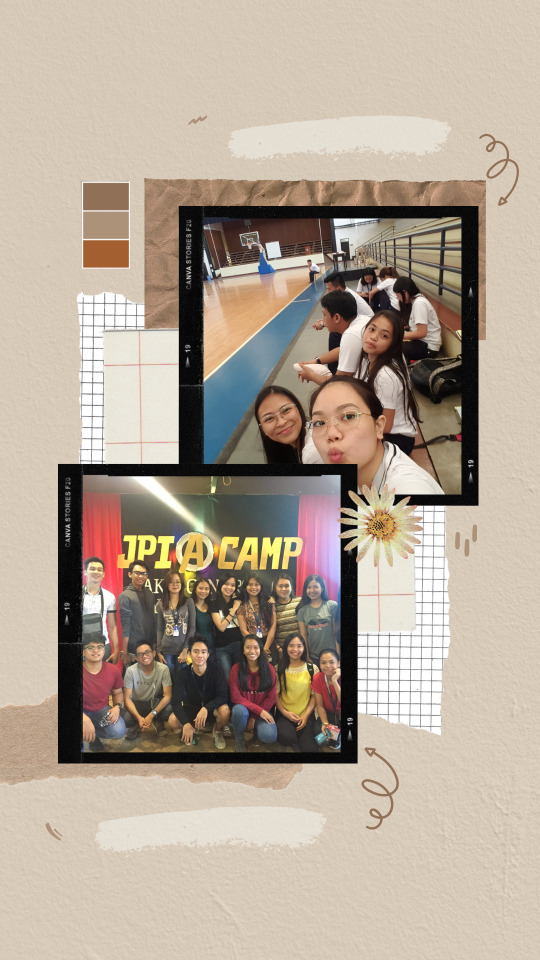
The pictures above were from my previous school which is at Xavier University. I still don’t have pictures of me in USTP since I didn’t get to attend face-to-face classes since the pandemic started.
What I miss about face-to-face classes is first and foremost, my allowance. Kidding aside, I miss my classmates who are with me through ups and downs every semester. I miss going out with them. We used to eat at fast food after class when we have free time. I miss our favorite hangout place which is Chingkee Tea, our favorite drink is their boba milk tea. I miss the sleepless nights because of our never-ending assignments and other paperwork. In face-to-face classes, you have to double time and multi-task always. When we are busy, we usually have our lunch for 15 minutes only and after that, we go back directly to our paperwork. I miss bringing very heavy books. I miss going to the library and falling asleep. In face-to-face, you will experience the real life of a student because you will always procrastinate like me, I procrastinate every day because I have a lot of homework to do especially in my course because I am an accountancy student before and I have 5 majors in the first year, first sem. But I didn’t complain about that because I like my course and I’m enjoying it.
In face-to-face classes, you will encounter different subject teachers with different personalities. Some teachers are terror and strict and some are approachable and understand their students. Even though they are strict with us, I still miss them. I miss wearing my uniform and doing physical activities at the gym. I miss going to the cafeteria to eat tempura, kwek-kwek, and pancit canton. I miss running to the hallway because I’m late. There are a lot of things I miss in face-to-face classes but I can’t name them all. But overall, I miss going to school. I wish this pandemic will end soon so that we will be able to have face-to-face classes.
0 notes
Note
LOVE the Runed! series! Got some questions sorry if they've been asked before! Is CoS NY a typical institute or an anomaly? I mean both in number of residents and operations? Or are there less than normal because it's all exiled people and there's stigma, if so why were they given such an important canton(hundreds of demon related deaths)? Do most active shadowhunters live in institutes or do they commute or stay in Idris for emergency deployment?
Hi lovely! I have not been online properly in ages - work is CRAZY, this is the first break I’ve had in a while and I want to spend it writing. Which means I’m totally using your questions (which, nope, as far as I recall haven’t been asked before) as a way of getting into the right headspace to FINISH THIS FUCKING CHAPTER.
Ahem.
ANYway - I’m so ridiculously delighted you like Runed :D Kind of can’t believe there are still people discovering it/following it after I’ve been so useless for so long. But yes, your questions.
The (Runed!)NY Institute is very atypical of how most Institutes are run, and yes, this is primarily because of the stigma attached to the Lightwoods. Usually a single individual or family will run an Institute, and they may or may not be the only ones living permanently in the building, but they are meant to oversee and organize all the other Shadowhunters in their canton (that is, the area under that Institute’s protection). A normal, healthy, well-run Institute has Shadowhunters moving in and out of it every day, checking in, training, using the Institute’s library or requisitioning weapons from their armoury, handing in reports, etc.
The NY one, as is obvious, does not. And that is because no one is willing to take an assignment that would place them under the Lightwoods’ authority. No one is willing to take orders from anyone who fought on the wrong side of the Uprising.
The Lightwoods got the Institute because they are purebloods and had a lot of connections, and ultimately no one was quite willing to execute members of one of the First Families (as is mentioned in the series, one of Jonathan Shadowhunter’s agelae was a Lightwood, so there have literally been Lightwoods as long as there have been Nephilim.) The Institute was a compromise; it’s exile, but it’s exile in style, kind of like how various nobles and royals throughout history have been ostensibly imprisoned in fairly luxurious conditions.
Most active Shadowhunters live outside Idris, either residing in their local Institute or in properties they buy themselves, or that have been bought for them by merchant-adventurers. That said, most Shadowhunters will also visit Idris a few times a year, especially for the major holidays or for events like weddings and funerals. Most members of the Shadowhunter caste who live full-time in Idris are either still in or just out of training, are retired from active duty, or were never in the field at all and focused on politics or other careers instead. There are also those who, for a variety of reasons, have not been assigned permanently to a particular canton, and can therefore be considered ‘on-call’ but not actively patrolling; this is considered an undesirable or shameful state to be in, and Shadowhunters in that position will generally jump at any chance to prove themselves worthy of permanent assignment somewhere outside of Idris.
Given how difficult arranging Portals is, commuting is not a sensible option for active Shadowhunters. If you patrol a canton, you live in it.
The NY Institute can also be considered unusual because Robert and Maryse are not nearly as on top of things as they should be. You might remember that Maryse couldn’t tell the Inquisitor where the packhomes of the local werewolf packs were, and of course there’s the fact that the Lightwood parents left Alec, Jace and Izzy completely alone to guard one of the biggest and most dangerous cantons in the USA. Shadowhunters are not very gentle with their children, but even by Shadowhunter standards that really wasn’t acceptable.
Feel free to throw more questions my way - I definitely appreciate anything that can get me back into the Runed headspace!
8 notes
·
View notes